Volume 28.3
September–December 2025
Full table of contents
ISSN: 1094-8074, web version;
1935-3952, print version
Recent Research Articles
See all articles in 28.3 September-December 2025
See all articles in 28.2 May-August 2025
See all articles in 28.1 January-April 2025
See all articles in 27.3 September-December 2024
Interested in submitting a paper to Palaeontologia Electronica?
Click here to register and submit.
Article Search
APPENDIX 1
Specimen registration numbers with lists of thin section numbers derived from them, showing the relevant Figure numbers.
NMS G.2014.33.10, Diplacanthus crassisimus from Corbie Den, Banffshire.
Figures 5.6, 12.1-4, NMS G.2014.33.10.2
Figure 12.5-7, NMS G.2014.33.10.1
NMS G.2014.33.9, Diplacanthus crassisimus from Corbie Den, Banffshire.
Figure 5.7, NMS G.2.14.33.9.1
NMS G.2014.44.2, Diplacanthus crassisimus from Corbie Den, Banffshire.
Figures 5.9, 8.10, NMS G.2014.44.2.1
NMS G.2014.33.8, Diplacanthus crassisimus from west of Castletown harbour, Caithness.
Figure 8.1, NMS G.2014.33.8.2
Figure 8.2, NMS G.2014.33.8.3
Figure 9.2, NMS G.2014.33.8.1-6
NMS G.2015.11.2, Diplacanthus crassisimus from Gamrie, Banffshire.
Figure 8.3-5, NMS G.2015.11.2.16
NMS G.2015.11.3, Diplacanthus crassisimus from Gamrie, Banffshire.
Figure 12.8-9, NMS G.2015.11.3.2
NMS G.2015.11.2, Diplacanthus crassisimus from Gamrie, Banffshire.
Figure 12.10, NMS G.2015.11.2.21
Figure 12.11, NMS G.2015.11.2.6
NMS G.2014.4.18, Diplacanthus tenuistriatus from Marwick, Orkney.
Figure 16.5-6, NMS G.2014.4.18.2
NMS G.2014.33.1, Diplacanthus tenuistriatus from North Ronaldsay, Orkney.
Figure 16.7, NMS G.2014.33.1.2
NMS G.2014.7.36, Diplacanthus tenuistriatus from Marwick, Orkney.
Figures 16.1-4, 17.1, NMS G.2014.7.36.1
Fig. 17.2, NMS G.2014.7.36.2
NMS G.2014.7.35, Diplacanthus tenuistriatus from Marwick, Orkney.
Figures 16.5-6, 17.3, NMS G.2014.7.35.1
Figure 17.4, NMS G.2014.7.35.2
NMS G.2014.4.20, Diplacanthus tenuistriatus from Marwick, Orkney.
Figures 18.6, 19, J2B
Figures 18.7-8, 19, J2A
Figures 18.9, 19, J2
Figure 19, I2
NMS G.2014.4.27, Diplacanthus tenuistriatus from Flashes, Hoy, Orkney.
Figure 18.1-11, D2
Figure 19, A2-F1, I1
NMS G.2014.4.23, Diplacanthus tenuistriatus from Marwick, Orkney.
Figure 19, 10A, 10B
NMS G.2014.20.20, Diplacanthus tenuistriatus from Marwick, Orkney.
Figure 20, K2, L2, M2, O1
NMS G.1897.55.1, Diplacanthus tenuistriatus from Achanarras Quarry, Caithness.
Figure 21.4-5, NMS G.1897.55.1.2
Figure 21.6-7, NMS G.1897.55.1.5
Figure 21.8, NMS G.1897.55.1.3
Figure 21.9, NMS G.1897.55.1.8
NMS G. Canon Kyle no.1 Diplacanthus tenuistriatus from Tynet Burn, Moray.
Figure 22.4, NMS G.Canon Kyle no. 1.2
Figure 22.5, NMS G.Canon Kyle no. 1.5
Figure 22.6-8, NMS G.Canon Kyle no. 1.11
NMS G.1892.8.9, Diplacanthus tenuistriatus from Gamrie, Banffshire.
Figure 22.10, NMS G.1892.8.9.15
Figure 22.11, NMS G.1892.8.9.13
Figure 22.12, NMS G.1892.8.9.6
Figure 22.13, NMS G.1892.8.9.4
Figure 22.14, NMS G.1892.8.9.6
Figure 22.15, NMS G.1892.8.9.5
Figure 22.16, NMS G.1892.8.9.7
NMS G.2015.11.1, Rhadinacanthus longispinus from Broad Taing, Orkney.
Figures 27.1-2, 30.4, NMS G.2015.11.1.3
NMS G.2014.4.33, Rhadinacanthus longispinus from the slates west of East Murkle Bay, Caithness.
Figure 27.3, NMS G.2014.4.33.2
Figure 27.4-5, NMS G.2014.4.33.4
Figure 30.1-2, NMS G.2014.4.33.1-8
NMS G.2014.33.2, Rhadinacanthus longispinus median spine from North Ronaldsay.
Figure 27.6, NMS G.2014.33.2.2
NMS G.2014.4.32, Rhadinacanthus longispinus from Achanarras Quarry, Caithness.
Figure 28.1, NMS G.2014.4.32.13
Figure 28.2, NMS G.2014.4.32.11
Figure 28.3-4, NMS G.2014.4.32.21
Figure 28.5, NMS G.2014.4.32.24
NMS G.2014.44.1, Rhadinacanthus longispinus from Cromarty, Ross and Cromarty.
Figure 28.6-7, NMS G.2014.44.1.16
NMS G.2014.33.2, Rhadinacanthus longispinus from the slates west of East Murkle Bay, Caithness.
Figure 30.3, NMS G.2014.33.2.2
NMS G.2014.44.1, Rhadinacanthus longispinus from Cromarty, Ross and Cromarty.
Figure 37.1, NMS G.2014.44.1.4
Figure 37.2, NMS G.2014.44.1.9
Figure 37.3-4, NMS G.2014.44.1.6
Figure 37.5, NMS G.2014.44.1.5
Figure 37.6, NMS G.2014.44.1.7
APPENDIX 2.
Characters 1-253 are adopted from Zhu et al. (2013). Changes to characters have been written in boldface type. Characters 254, 255 are extra characters added by Dupret et al. (2014). Characters 256-262 are newly added characters.
Changes to codings in the data matrix from Zhu et al. (2013) have been highlighted in blue in the new data matrix (Appendix 3); the red highlighting used by Zhu et al. (2013) to show their coding changes has also been retained. Many of the unknown (?) codings in their analysis have been corrected to inapplicable (-), even though it is understood that codings (-) and (?) are treated equally in the phylogenetic analysis.
Character codings have been added or changed based on photographs of all acanthodian specimens in the National Museums Scotland and the ?stem chondrichthyan Doliodus in the New Brunswick Museum (BNHM) collections, and our work on the Lower and Middle Devonian acanthodians of Scotland, as well as the following publications for specified taxa:
Brochoadmones: Hanke and Wilson (2006);
Cassidiceps: Gagnier and Wilson (1996);
Climatius: Burrow et al. (2015);
Culmacanthus: Long (1983), Burrow and Young (2012);
Diplacanthus: Gross (1947: type species Diplacanthus crassisimus, referred by Gross to D. striatus, a junior synonym), Young (1995);
Euthacanthus: Newman et al. (2011, 2014);
Gladiobranchus = Uraniacanthus - previous analyses included the acanthodian Gladiobranchus in the taxon list, but Newman et al. (2012) demonstrated that G. probaton should be reassigned to Uraniacanthus, by priority: Hanke and Davis (2008), Newman et al. (2012);
Kathemacanthus: Hanke and Wilson (2010);
Lupopsyrus: Hanke and Davis (2012);
Nerepisacanthus: Burrow (2011), Burrow and Rudkin (2014);
Obtusacanthus: Hanke and Wilson (2004);
Parexus: Burrow et al. (2013);
Ptomacanthus: Brazeau (2012);
Rhadinacanthus: Gross (1947: R. longispinus was referred by Gross to Diplacanthus ), Young (1995);
Tetanopsyrus: Hanke et al. (2001);
All MOTH acanthodian taxa: Hanke (2001);
Various acanthodian taxa: Miles (1966, 1973a, b), Watson (1937), and Burrow et al. (2011).
1. Tessellate calcified cartilage : absent (0); present (1).
This character was previously specified tessellate prismatic calcified cartilage, but histological study has been made of very few mid-Palaeozoic taxa, hence we have omitted 'prismatic' from the character. Doliodus should be coded as (?), because the calcified cartilage resembles the irregularly patterned calcified cartilage in acanthodians, rather than the regular tessellate pattern of polygonal tesserae in Late Devonian and younger chondrichthyans.
2. Perichondral bone: present (0); absent (1).
3. Extensive endochondral ossification: absent (0); present (1).
4. Dentine: absent (0); present (1).
Of the two outgroups, galeaspids lack dentine, whereas osteostracans have dentine. Earliest representatives of all gnathostome groups for which histological structure is known, have dentine, even though younger taxa can lack this tissue (e.g. the Early Devonian antiarch Parayunnanolepis vs. Late Devonian Bothriolepis ). However, we have kept the polarity used in previous studies but note that we are not convinced that (0) represents the general condition. Codings for several taxa are changed from (?) to (1): studies in progress on the Old Red Sandstone acanthodians of Scotland show that Brachyacanthus, Ischnacanthus, Mesacanthus and Rhadinacanthus scales are dentinous (CJB pers. obs.); Hanke (2001, fig. 130) figured Cassidiceps scale structure; eroded scales of Culmacanthus (Long 1983) show the dentinous structure of the crown; Schultze (1968) illustrated the dentinous histology of Dialipina; Both Doliodus teeth and scales are dentinous (BNHM collection, CJB pers. obs.); Hanke and Davis (2012, fig. 6G) figured Lupopsyrus scale structure; Burrow et al. (2013, fig. 13) figured Parexus scale structure; Brazeau (2012, fig. 7) figured Ptomacanthus scale structure.
5. Type of dentine: mesodentine (0); semidentine (1); orthodentine (2).
Codings for several taxa have been changed from previous matrices: studies in progress on the Old Red Sandstone acanthodians of Scotland show that Brachyacanthus and Diplacanthus and Rhadinacanthus have mesodentine; Uraniacanthus has mesodentine, cf. Hanke and Davis (2008, fig. 13); Ischnacanthus and Mesacanthus scales have orthodentine (CJB pers. obs.); Lupopsyrus scales have Stranggewebe, a form of mesodentine, cf. Hanke and Davis (2012); Obtusacanthus has mesodentine including Stranggewebe (Hanke and Wilson 2004, fig. 10); Parexus teeth have mesodentine (Burrow et al. 2013); Promesacanthus scales have orthodentine (Hanke 2008, fig. 7); Ptomacanthus scales have mesodentine including Stranggewebe, cf. Brazeau (2012);
6. Cosmine: absent (0); present (1).
7. Lepidotrichia or lepidotrichia-like scale alignment: present (0); absent (1).
Fin webs preserved on specimens of Parexus and Rhadinacanthus in the NMS collection show this type of scale alignment.
8. Body scale growth pattern: monodontode (0); polyodontode (1).
Brachyacanthus, Climatius, Ischnacanthus, Mesacanthus and Rhadinacanthus scales are polyodontode (Burrow et al., 2015; this paper; CJB pers. obs.); eroded Culmacanthus scales show superposed growth zones (Long, 1983).
9. Body scale growth concentric: absent (0); present (1).
Brachyacanthus and Climatius scales show areal growth and so are coded (0), Ischnacanthus , Mesacanthus and Rhadinacanthus show superposed growth (this paper, CJB pers. obs.); eroded Culmacanthus scales show superposed growth zones (Long, 1983); Obtusacanthus is monodontode, so is coded (-) for this character; Ptomacanthus is coded (1) based on Brazeau (2012, fig. 7A, D). Cladoselache and Coccosteus are also coded (0). However, some taxa ( Ptomacanthus and Nerepisacanthus ) have body scales showing concentric growth, as well as other post-tectal scales showing areal growth crowns. For this reason, we have added a new character 260 to code for the latter type.
10. Body scales with peg-and-socket articulation: absent (0); present (1).
Brachyacanthus and Rhadinacanthus are coded (0) based on CJB (pers. obs.) and Gross (1947); Vernicomacanthus is coded (0) based on the description by Miles (1966).
11. Body scale profile: distinct crown and base demarcated by a constriction (neck) (0); flattened (1).
Brachyacanthus, Climatius, and Doliodus are coded (1), Diplacanthus and Rhadinacanthus are coded (0) based on Gross (1947); Parexus is coded (1) based on Burrow et al. (2013).
12. Body scales with bulging base: absent (0); present (1).
Doliodus and Diplacanthus are coded (0), Mesacanthus and Rhadinacanthus are coded (1), based on Gross (1947) and this paper; Lupopsyrus is coded (0) based on Hanke and Davis (2012); Parexus is coded (0) based on Burrow et al. (2013).
13. Body scales with flattened base: absent (0); present (1).
Lupopsyrus and Parexus are coded (1); Rhadinacanthus is coded (0) based on this paper.
14. Flank scale alignment: vertical rows (0); oblique rows or hexagonal/rhombic packing (1); disorganised (2).
Rhadinacanthus is coded (1) based on this paper.
15. Sensory line canal: passes between or beneath scales (0); passes over scales and/or is partially enclosed or surrounded by scales (1); perforates and passes through scales (2).
Sensory lines pass between the specialised 'umbellate' scales on the head of Brochoadmones (Hanke and Wilson, 2006); there is no sign of sensory lines on the head tesserae of Cassidiceps (Gagnier and Wilson, 1996), and the lateral lines run between scales. Uraniacanthus is recoded (0) as lateral lines run between scales, and the infraorbital sensory line appears to run between scales and a circumorbital plate (Hanke and Davis, 2008, fig. 7C), not over scales.
16. Sensory line network: preserved as open grooves (sulci) in dermal bones (0); sensory lines pass through canals enclosed within dermal bones (1).
For all acanthodians which lack dermal bones, this character is coded (-), inapplicable.
17. Jugal portion of infraorbital canal joins supramaxillary canal: present (0); absent (1).
18. Dermal skull roof: includes large dermal plates (0); consists of undifferentiated plates or tesserae (1).
Rhadinacanthus is coded (1) based on NMS specimens (this paper).
19. Tessera morphology: large interlocking polygonal plates (0); microsquamose, not larger than body squamation (1).
Rhadinacanthus and Vernicomacanthus are coded (1) based on NMS specimens (this paper; CJB pers. obs.).
20. Extent of dermatocranial cover: complete (0); incomplete (scale-free cheek and elsewhere) (1).
Mesacanthus and Rhadinacanthus are coded (0) based on NMS specimens (this paper; CJB pers. obs.).
21. Endolymphatic ducts open in dermal skull roof: present (0); absent (1).
For consistency, this character is coded as (?) in all acanthodians with plates larger than scales and tesserae on the skull roof, and (-) for those with scales or tesserae, as none of these taxa have plates on the skull roof so the character is inapplicable. Doliodus should be coded (?), as its head cover is not known.
22. Endolymphatic ducts with oblique course through dermal skull bones: absent (0); present (1).
23. Series of paired median skull roofing bones that meet at the dorsal midline of the skull (rectilinear skull roof pattern): absent (0); present (1).
All acanthodians which lack dermal skull roof plates should be coded (-), inapplicable.
24. Consolidated cheek plates: absent (0); present (1).
Diplacanthus, Rhadinacanthus and Culmacanthus have cheek plates, Cheiracanthus, Climatius, Lupopsyrus and Mesacanthus do not (Watson, 1937; Hanke and Davis, 2012; Burrow et al., 2015; CJB pers. obs.). This character is coded (1) for Uraniacanthus and Culmacanthus (Long 1983, fig. 3A) which have plates posterior to the circumorbital series in a comparable position to the cheek plate of (other) diplacanthiforms. This element differs from character 26, which refers to an element posterodorsal to the orbit (present in Climatius and Parexus ).
25. Pineal opening perforation in dermal skull roof: present (0); absent (1).
Once again, for consistency, this character should be coded as (?) in all acanthodians which have a dermal skeleton (whether scales or tesserae or plates) over the skull roof, rather than (-) in some and (?) in others, and also for Doliodus, where presence/absence of a dermal cover is unknown.
26. Enlarged postorbital tessera separate from orbital series , over the otic region : absent (0); present (1).
The structure in Uraniacanthus appears to be posterior to the circumorbital bones (Hanke and Davis, 2008, fig. 5), and is in the same position as the cheek plates of (other) diplacanthiforms; Lupopsyrus lacks any large tesserae in the cheek/postorbital region (Hanke and Davis, 2012, figs. 1, 2) and is coded (0).
27. Bony hyoidean gill-cover series (branchiostegals): absent (0); present (1).
Davis et al. (2012) coded Acanthodes as state (0), although they admitted that the objectivity of their recoding of this character from previous analyses was questionable; nor did they give any evidence to support their reinterpretation of the structures as endoskeletal rather than dermal elements. The only character by which these structures in Acanthodes and Homalacanthus differ from those in other acanthodiforms appears to be their lack of ornament. We maintain the traditional view that the thin rays/plates in Acanthodes and Homalacanthus are dermal structures homologous with those in other acanthodiforms, and code them as (1). The following characters 28-31 are also recoded for these two taxa, in line with our interpretation of these structures. Obtusacanthus lacks branchiostegals (Hanke and Wilson, 2004) and is coded (0), with the following characters 28-31 coded (-) inapplicable.
28. Branchiostegal plate series along ventral margin of lower jaw: absent (0); present (1).
Parexus has elongated diamond-shaped plates below the angle of the jaw, but they are possibly not homologous with the branchiostegal plates above the jaw angle and so are coded (?); Climatius is coded (1) and Rhadinacanthus coded (0), based on CJB (pers. obs.).
29. Branchiostegal ossifications plate-like (0); narrow and ribbon-like (1).
These structures are plate-like in Euthacanthus (Watson, 1937).
30. Branchiostegal ossifications ornamented (0); unornamented (1).
These structures are ornamented in Euthacanthus and Cheiracanthus (Watson, 1937; Miles, 1966).
31. Imbricated branchiostegal ossifications: absent (0); present (1).
The ossifications are separated in Acanthodes, Cheiracanthus and Homalacanthus, so are coded (0); they are contiguous in Brachyacanthus and Climatius, but it is unclear if they overlap and so these taxa are coded (?); in Ischnacanthus the ossifications are irregularly shaped, but appear to be separate, so it is coded (0).
32. Opercular cover of branchial chamber complete or partial (0); separate gill covers and gill slits (1).
Vernicomacanthus has branchiostegal plates (Miles, 1973a), so is coded (0).
33. Opercular (submarginal) ossification: absent (0); present (1).
Acanthodians with micromeric dermal covering on the head are coded (0); those with plates between the orbits and branchial plates which are larger than tesserae and scales, including diplacanthiforms, are coded (?), as it is unclear if any of these plates are homologous with submarginal plates.
34. Shape of opercular (submarginal) ossification: broad plate that tapers towards its proximal end (0); narrow, rod-shaped (1).
35. Gular plates: absent (0); present (1).
Acanthodians Climatius and Parexus have fine short gular 'rays' anteroventral to the branchiostegals, but these structures are not morphologically comparable with the gular plates of osteichthyans and Entelognathus and so coding as (0) is retained. Poracanthodes and Rhadinacanthus are coded (0) rather than (?), as they (like other acanthodians with this region preserved) show no evidence for such plates; these taxa are thus coded (-) for character
36. Size of lateral gular plates: extending most of length of the lower jaw (0); restricted to the anterior third of the jaw (no longer than the width of three or four branchiostegals) (1).
37. Basihyal: present (0); absent, hyoid arch articulates directly with basibranchial (1).
38. Interhyal: absent (0); present (1).
39. Oral dermal tubercles borne on jaw cartilages: absent (0); present (1).
Brachyacanthus, Culmacanthus, Euthacanthus and Rhadinacanthus all lack teeth or tooth-like structures on the jaws (Watson 1937, Burrow and Young, 2012; CJB pers. obs.). Taxa coded (0) for this character are coded (-) for characters 40-43. Achoania is coded (1) (Zhu et al., 2001).
40. Tooth whorls: absent (0); present (1).
This character could possibly be considered independent of character 39, as symphysial tooth whorls appear to have developed between and not on the jaw cartilages, and extraoral elements indistinguishable from tooth whorls occur in some ischnacanthids (Blais et al., 2011). Tetanopsyrus lacks tooth whorls (Hanke et al., 2001) and is coded (0).
41. Bases of tooth whorls: single, continuous plate (0); some or all whorls consist of separate tooth units (1).
42. Enlarged adsymphysial tooth whorl: absent (0); present (1).
43. Teeth ankylosed to dermal bones: absent (0); present (1).
Brochoadmones, Climatius, Parexus and Vernicomacanthus have only separate tooth whorls borne on jaw cartilages and are coded (0). Tetanopsyrus lindoei (Hanke et al., 2001, fig. 3B) has rounded 'denticles' on the lingual surface of otherwise smooth occlusal surfaces on the jaw cartilages, but these appear to be ossified bumps rather than teeth, so Tetanopsyrus is coded as (0).
44. Dermal jaw plates on biting surface of jaw cartilages: absent (0); present (1).
It is uncertain if the occlusal jaw plates in diplacanthiforms and Tetanopsyrus are dermal or endoskeletal developments. Like Diplacanthus, other diplacanthiforms Culmacanthus, Uraniacanthus and Rhadinacanthus have smooth plates on the Meckel's cartilages (Burrow and Young, 2012; Newman et al., 2012; CJB pers. obs.), whereas Tetanopsyrus has mineralized upper and lower jaws, with no distinct separation between the biting surface and the rest of the jaw (Hanke et al., 2001, fig. 3A, B). We have added a new character 259 for smooth surfaced occlusal dental plates.
45. Maxillary and dentary tooth-bearing bones: absent (0); present (1).
Cassidiceps and Kathemacanthus are coded (0), as there is no evidence of these bones in the mouth region of either species.
46. Large otic process of the palatoquadrate: absent (0); present (1).
Euthacanthus has a palatoquadrate of typical acanthodian shape, and is coded (1) for this and character 47.
47. Insertion area for jaw adductor muscles on palatoquadrate: ventral or medial (0); lateral (1).
This character is uncertain for Kathemacanthus (Hanke and Wilson, 2010, fig. 6A), and coded (?).
48. Oblique ridge or groove along medial face of palatoquadrate: absent (0); present (1).
Climatius has this feature, and is coded (1).
49. Fenestration of palatoquadrate at basipterygoid articulation: absent (0); present (1).
Mesacanthus and Poracanthodes both lack a fenestration, and are coded (0), based on CJB (pers. obs.) and Valiukevičius (1992).
50. Perforate or fenestrate anterodorsal (metapterygoid) portion of palatoquadrate: absent (0); present (1).
51. Pronounced dorsal process on Meckelian bone or cartilage: absent (0); present (1).
Culmacanthus dental plates have this process (Burrow and Young, 2012, fig. 4a, b), and it is coded (1); Diplacanthus plates lack the process and it is coded (0); Euthacanthus cartilages lack a process and it is also coded (0).
52. Preglenoid process: absent (0); present (1).
The jaw articulation area is poorly preserved in all Climatius reticulatus institutional specimens, and presence or absence of this process is uncertain; Climatius is coded (?).
53. Jaw articulation located on rearmost extremity of mandible: absent (0); present (1).
54. Precerebral fontanelle: absent (0); present (1).
55. Median dermal bone of palate (parasphenoid): absent (0); present (1).
Despite examples with the inferred palatal region being preserved in all acanthodians in this analysis, none show evidence for a palatal bone, so they are all coded as (0). Several previous analyses (Brazeau, 2009; Davis et al., 2012; Zhu et al., 2013) coded most acanthodians as (?), unknown, but if there was a bone, whether denticulated or not, then it would be visible in acanthodians which have the head region preserved, even if none of the cartilaginous endoskeleton is preserved. We can often see both the external surface features of the exposed side, as well as the internal surfaces of the other side of the fish, particularly in the MOTH fishes but also in many LORS acanthodian species - if there was a bone between the two sides of the head, then it should be visible, at least as a lump in the scale/tessera cover or exposed when the upper dermal cover is incomplete. Given the excellent preservation of MOTH fish, where even statoconia are easily seen, an actual bone would be visible when the head region is preserved.
56. Nasal opening(s): dorsal, placed between orbits (0); ventral and anterior to orbit (1).
Nares have been identified anterior to the orbits in Culmacanthus (Long, 1983), Diplacanthus (Watson, 1937), Euthacanthus (Newman et al., 2014), Parexus (Burrow et al., 2013), and Nerepisacanthus (Burrow and Rudkin, 2014), and these are coded as (1).
57. Olfactory tracts: short, with olfactory capsules situated close to telencephalon cavity (0); elongate and tubular (much longer than wide) (1).
58. Prominent pre-orbital rostral expansion of the neurocranium: present (0); absent (1).
Recently described specimens of Lupopsyrus (Hanke and Davis, 2012), and NMS specimens of Rhadinacanthus (CJB pers. obs.) indicate coding (1) for these taxa.
59. Pronounced sub-ethmoidal keel: absent (0); present (1).
60. Position of myodome for superior oblique eye muscles: posterior and dorsal to foramen for nerve II (0); anterior and dorsal to foramen (1).
61. Endoskeletal intracranial joint: absent (0); present (1).
62. Spiracular groove on basicranial surface: absent (0); present (1).
63. Spiracular groove on lateral commissure: absent (0); present (1).
64. Subpituitary fenestra: absent (0); present (1).
65. Supraorbital shelf broad with convex lateral margin: absent (0); present (1).
Kathemacanthus is coded (?) as this region is not preserved in any specimens reliably assignable to the genus (Hanke and Wilson, 2010).
66. Orbit dorsal or facing dorsolaterally, surrounded laterally by endocranium: present (0); absent (1).
In Cheiracanthus, Climatius, Euthacanthus, Ischnacanthus, Mesacanthus and Promesacanthus the orbits are positioned laterally, and edged posteriorly and posteroventrally by the palatoquadrate, precluding the endocranium surrounding the orbit laterally.
67. Extended prehypophysial portion of sphenoid: absent (0); present (1).
68. Narrow interorbital septum: absent (0); present (1).
69. The main trunk of facial nerve (N. VII): elongate and passes anterolaterally through orbital floor (0); stout, divides within otic capsule at the level of the postorbital process (1).
70. Hyoid ramus of facial nerve (N. VII) exits through posterior jugular opening: absent (0); present (1).
71. Glossopharyngeal nerve (N. IX) exit: foramen situated posteroventral to otic capsule and anterior to metotic fissure (0); through metotic fissure (1).
72. Short otico-occipital region of braincase: absent (0); present (1).
73. Ethmoid region elongate with dorsoventrally deep lateral walls: absent (0); present (1).
74. Basicranial morphology: platybasic (0); tropibasic (1).
75. Ascending basisphenoid pillar pierced by common internal carotid: absent (0); present (1).
76. Jugular vein: invested in otic capsule wall posterior to the postorbital process (0); lateral wall of jugular canal incomplete or absent (1).
77. Canal for lateral dorsal aorta within basicranial cartilage: absent (0); present (1).
78. Entrance of internal carotids: through separate openings flanking the hypophyseal opening or recess (0); through a common opening at the midline of the basicranium (1).
79. Canal for efferent pseudobranchial artery within basicranial cartilage: absent (0); present (1).
80. Position of basal/basipterygoid articulation: same anteroposterior level as hypophysial opening (0); anterior to hypophysial opening (1).
81. Postorbital process articulates with palatoquadrate: absent (0); present (1).
82. Labyrinth cavity separated from the main neurocranial cavity by a cartilaginous or ossified capsular wall (0); skeletal capsular wall absent (1).
83. Basipterygoid process (basal articulation) with vertically oriented component: absent (0); present (1).
84. Pituitary vein canal dorsal to level of basipterygoid process (0); flanked posteriorly by basipterygoid process (1).
85. External (horizontal) semicircular canal: absent (0); present (1).
86. Sinus superior: absent or indistinguishable from union of anterior and posterior canals with saccular chamber (0); present (1).
Following Dupret et al. (2014), this character has been recoded (1) for Galeaspida.
87. External (horizontal) semicircular canal: joins the vestibular region dorsal to posterior ampulla (0); joins the vestibular region levelling with posterior ampulla (1).
88. Trigemino-facial recess: absent (0); present (1).
89. Posterior dorsal fontanelle: absent (0); present (1).
90. Shape of posterior dorsal fontanelle: approximately as long as broad (0); much longer than wide, slot-shaped (1).
91. Dorsal ridge: absent (0); present (1).
92. Endolymphatic ducts: posteriodorsally angled tubes (0); tubes oriented vertically through median endolymphatic fossa (1).
93. Lateral otic process: absent (0); present (1).
94. Process forming part or complete wall of jugular groove or canal projecting from otic capsule wall: absent (0); present (1).
95. Position of hyomandibula articulation on neurocranium: below or anterior to orbit, on ventrolateral angle of braincase (0); posterior to orbit (1).
96. Ventral cranial fissure: absent (0); present (1).
97. Metotic (otic-occipital) fissure: absent (0); present (1).
98. Vestibular fontanelle: absent (0); present (1).
99. Occipital arch wedged in between otic capsules: absent (0); present (1).
100. Spino-occipital nerve foramina: two or more, aligned horizontally (0); one or two, aligned dorsoventrally (1).
101. Ventral notch between parachordals: absent (0); present or entirely unfused (1).
102. Parachordal shape: broad, flat (0); keeled with sloping lateral margins (1).
103. Hypotic lamina (and dorsally directed glossopharyngeal canal): absent (0); present (1).
104. Macromeric dermal shoulder girdle: present (0); absent (1).
105. Dermal shoulder girdle composition: ventral and dorsal (scapular) components (0); ventral components only (1).
Diplacanthus was previously coded (0), but the dermal ornament on the scapula comprises scales and tesserae attached to the endoskeletal scapula; Rhadinacanthus and Vernicomacanthus also lack dorsal components (NMS collection, CJB pers. obs.).
106. Dermal shoulder girdle forming a complete ring around the trunk: present (0); absent (1).
All acanthodians with a dermal shoulder girdle component are coded (1), as all acanthodian taxa in the analysis lack a dermal bone component to the dermal shoulder girdle so cannot have a complete ring; other acanthodians are coded (-).
107. Pectoral fenestra completely encircled by dermal shoulder armour: present (0); absent (1).
All acanthodians with a dermal shoulder girdle component are coded (1), as they lack a dermal component to the dermal shoulder girdle so the pectoral fenestra cannot be completely encircled; other acanthodians are coded (-).
108. Median dorsal plate: absent (0); present (1).
109. Pronounced internal crista (‘keel’) on median dorsal surface of shoulder girdle: absent (0); present (1).
110. Scapular process of endoskeletal shoulder girdle: absent (0); present (1).
111. Ventral margin of separate scapular ossification: horizontal (0); deeply angled (1).
Euthacanthus is coded (0); Rhadinacanthus is coded (1), based on CJB pers. obs.
112. Cross-sectional shape of scapular shaft : flattened or strongly ovate (0); subcircular (1).
Cassidiceps is coded (0), based on Gagnier and Wilson (1996, p. 253: scapular blade is short and has a flat internal face"); Culmacanthus (Long, 1983, fig. 6) and Diplacanthus are coded (1), based on NMS specimens (CJB pers. obs.); Lupopsyrus is coded (0); Uraniacanthus is coded (1), as the central shaft is subcircular in cross-section, even though the anterior and posterior flanges give the scapula a flattened appearance.
113. Flange on trailing edge of scapulocoracoid: absent (0); present (1).
Although the flange is not as large as on Diplacanthus, Culmacanthus has a short flange so is coded (1).
114. Scapular process with posterodorsal angle: absent (0); present (1).
Rhadinacanthus and Vernicomacanthus lack this feature and are coded (0), based on NMS specimens (CJB pers. obs.).
115. Endoskeletal postbranchial lamina on scapular process: present (0); absent (1).
Lupopsyrus lacks this structure (Hanke and Davis, 2012, fig. 5) and is coded (1); Promesacanthus appears to have a triangular region anteriorly on the scapula (Hanke, 2008, fig. 4) which could possibly be interpreted as a postbranchial lamina, so it is coded (?); Rhadinacanthus is coded (0), based on NMS specimens (CJB pers. obs.). Following Dupret et al. (2014), Galeaspida has been recoded from (0) to (-).
116. Mineralisation of internal surface of scapular shaft : mineralised all around (0); unmineralised on internal face forming a hemicylindrical cross-section (1).
Davis et al. (2012) referred to a scapular blade, which is the notation used for the ventral expansion of the scapula; the dorsal portion is usually termed the scapular shaft. In Lupopsyrus, the shaft is mineralised all around so it is coded (0); in Mesacanthus , only the internal face is ossified (CJB pers. obs.), so it is coded (1); Rhadinacanthus scapulocoracoid resembles that of Diplacanthus, and is coded (0), based on CJB (pers. obs.); in Tetanopsyrus the flattened preservation of the structure (Hanke et al., 2001, figs. 2A, 3E, 6A) precludes an assessment of the extent of mineralisation, so it is coded (?).
117. Coracoid process: absent (0); present (1).
As listed by Brazeau (2009), this character appears to necessarily refer to a mineralised process. If so, then Climatius , Euthacanthus, Ischnacanthus, Lupopsyrus, Parexus, Poracanthodes and Rhadinacanthus should be coded (0), as they have perichondrally ossified scapulas with a straight ventral margin, lacking any processes. Brochoadmones coding is changed to (-) as the pectoral girdle is not mineralised; Uraniacanthus is coded (?), as this region is not well preserved in any figured specimens, a coracoid process is not mentioned in the description by Hanke and Davis (2008) and their figure 8B is apparently based on a distorted specimen (Hanke and Davis, 2008, p. 314).
118. Procoracoid mineralisation: absent (0); present (1).
Diplacanthus, Rhadinacanthus have a mineralised procoracoid (CJB pers. obs. of NMS specimens), so are coded (1).
119. Fin base articulation on scapulocoracoid: stenobasal (0); eurybasal (1).
All acanthodians probably have a stenobasal articulation, but only those in which the fin is preserved have been coded (0); other taxa have been left as (?).
120. Perforate propterygium: absent (0); present (1).
121. Pelvic fins: absent (0); present (1).
122. Pelvic claspers: absent (0); present (1).
All acanthodian taxa in which the pelvic region is preserved, with pelvic fin spines and often pelvic fins, lack any mineralised structures which could be interpreted as pelvic claspers, and are thus coded (0). Cladoselache has been coded (?), after Long et al. (2015). The extra and revised codings added by the latter have not been included.
123. Dermal pelvic clasper ossifications: absent (0); present (1).
If taxa are coded (0) for character 122, then they are now coded (-) for this character.
124. Pectoral fins covered in macromeric dermal armour: absent (0); present (1).
125. Pectoral fin base has large, hemispherical dermal component: absent (0); present (1).
126. Dorsal fin spines: absent (0); present (1).
127. Anal fin spine: absent (0); present (1).
128. Paired pectoral fin spines: absent (0); present (1).
129. Median fin spine insertion: shallow, not greatly deeper than dermal bones/ scales (0); deep (1).
Kathemacanthus, Lupopsyrus, Obtusacanthus, Parexus, Poracanthodes and Vernicomacanthus all have shallowly inserted median spines, so are coded (0).
130. Prepelvic fin spines: absent (0); present (1).
This character was previously "intermediate fin spines", and included admedian spines medial to the pectoral fin spines. Admedian spines are here considered different structures, and coded as a separate character (256).
131. Prepectoral fin spines: absent (0); present (1).
The spine series between the pectoral spines in Kathemacanthus are regarded here as admedian (new character 256) not prepectoral spines, so coding is changed to (0).
132. Fin spines with ridges: absent (0); present (1).
133. Median and paired fin spines with nodes: absent (0); present (1).
Prepectoral, admedian and prepelvic spines often have a different ornament to the median, pectoral and pelvic spines, so only the latter are coded here.
134. Dorsal fin spines with rows of large retrorse denticles: absent (0); present (1).
Both pectoral and dorsal fin spines with such denticles are known, but occur in different taxa. Orthacanthus and Parexus are coded (1). Pectoral fin spines with these denticles are here considered as separate character (258).
135. Synarcual: absent (0); present (1).
136. Number of dorsal fins, if present: one (0); two (1).
137. Anal fin: absent (0); present (1).
138. Caudal radials: extend beyond level of body wall and deep into hypochordal lobe (0); radials restricted to axial lobe (1).
Characters added by Zhu et al. (2013)
Skeletal Tissues
139. Resorption and redeposition of odontodes: lacking or partially developed (0); developed (1).
No acanthodian taxa in which histological structure of scales and spines have been investigated, show evidence for resorption, so such taxa have been recoded (0).
140. Acrodin: absent (0); present (1).
Taxa lacking teeth are coded (-); Climatius, Doliodus, Ischnacanthus, Parexus, Poracanthodes and Ptomacanthus are coded (0), as the histological structure of their teeth has been studied and acrodin is lacking.
141. Plicidentine: absent (0); simple or generalized polyplacodont (1).
Taxa lacking teeth are coded (-); the same acanthodians listed in 140 are also coded (0) for this character.
142. Rostral tubuli: absent (0); present (1).
Dermal Skeleton: scales and fins
143. Peg on rhomboid scale: narrow (0); broad (1).
144. Anterodorsal process on scale: absent (0); present (1).
145. Fringing fulcra: absent (0); present (1).
No acanthodians (or chondrichthyans) known from specimens with fins preserved have lepidotrichia (although most have rows of scales on the fins, they are not regarded as being homologous with lepidotrichia); none can then have fringing fulcra (specialised lepidotrichia), and should be coded (-), inapplicable for this and character 146.
146. Epichordal lepidotrichia in caudal fin: absent (0); present (1).
Dermal Skeleton: skull
147. Dermal intracranial joint: absent (0); present (1).
148. Large unpaired median skull roofing bone anterior to the level of nasal capsules: absent (0); present (1).
149. Number of nasals: many (0); one or two (1).
Clearly defined specialized bones surrounding the nares are known in a number of acanthodians, including Brochoadmones , Cassidiceps, Climatius, Culmacanthus, Euthacanthus, Ischnacanthus, Homalacanthus, Mesacanthus, Nerepisacanthus, Ptomacanthus, so these taxa are coded (0). Other acanthodians with plates larger than scales and tesserae in the head region could possibly have nasals as well, and so are coded (?).
150. Mesial margin of nasal: not notched (0); notched (1).
Acanthodians with nasals have a ring of bones rather than a single nasal bone, and so their coding as (-), inapplicable, is retained.
151. Dermintermedial process: absent (0); present (1).
152. Posterior nostril: associated with orbit (0); not associated with orbit (1).
Culmacanthus has two pairs of nares (Long, 1983, fig. 5), and is coded (1); although their presence or absence is uncertain in other acanthodians, they should all be coded (?), rather than some as (-) and others as (?).
153. Position of posterior nostril: external, far from jaw margin (0); external, close to jaw margin (1).
The position of the posterior nostril is between the orbits and far from the jaw margin in Culmacanthus, so it is coded (0); all other acanthodians are coded (?).
154. Supraorbital (sensu Cloutier and Ahlberg, 1996, including posterior tectal of Jarvik): absent (0); present (1).
155. Supraorbital, preorbital and nasal: unfused (0); fused (1).
156. Tectal (sensu Cloutier and Ahlberg, 1996, not counting the ‘posterior tectal’ of Jarvik): absent (0); present (1).
157. Lateral plates: absent (0); present (1).
158. Location of pineal foramen/eminence: level with posterior margin of orbits (0); well posterior of orbits (1).
159. Parietals (preorbitals of placoderms) surround pineal foramen/eminence: yes (0); no (1).
160. Complete enclosure of spiracle by skull-roof bones: absent (0); present (1).
161. Number of marginal bones alongside paired median skull roofing bones over the otico-occipital division of braincase: single (0); two or more (1).
162. Number of paranuchals: one pair (0), two pairs (1).
163. Large unpaired median bone contributing to posterior margin of skull roof: absent (0); present (1).
164. Contact of nuchal or centronuchal plate with paired preorbital plates: absent (0), present (1).
165. Posterior process of the paranuchal plate behind the nuchal plate (dorsal face): absent (0), present (1).
166. Junction of posterior pitline and main lateral line: far in front of posterior margin of skull roof (0), close to posterior margin of skull roof (1).
167. Number of extrascapulars: uneven (0); paired (1).
168. Dermal neck-joint between paired main-lateral-line-bearing bones of skull and shoulder girdle: absent (0); present (1).
169. Type of dermal neck-joint: sliding, dermal shoulder girdle plate with flat articluar flange (0); ginglymoid, dermal shoulder girdle plate with articular condyle or fossa (1)
170. Number of sclerotic plates: four or less (0); more than four (1).
As noted by Burrow et al. (2011), most acanthodians have a sclerotic ring comprising five or six plates: codings for Brachyacanthus, Climatius, Euthacanthus, Parexus and Ptomacanthus are accordingly changed to (1); codings for acanthodians Brochoadmones, Diplacanthus, Uraniacanthus, Ischnacanthus, Kathemacanthus, Lupopsyrus, Obtusacanthus, Rhadinacanthus and Tetanopsyrus are changed to (-) as these taxa lack a sclerotic ring (see new character 258).
171. Foramina (similar to infradentary foramina) on cheek bones: absent (0); present (1).
172. Lacrimal posteriorly enclosing posterior nostril: absent (0); present (1).
173. Most posterior major bone of cheek bearing preopercular canal (“preopercular”) extending forward, close to orbit: absent (0); present (1).
Acanthodes, Brochoadmones, Cheiracanthus, Euthacanthus, Uraniacanthus, Ischnacanthus, Kathemacanthus, Lupopsyrus, Mesacanthus, Obtusacanthus, Poracanthodes, Promesacanthus and Tetanopsyrus have only scales or tesserae in the cheek region, so are coded (-).
174. Number of cheek bones bearing preopercular canal posterior to jugal: one (0); two (1).
175. Bone bearing both quadratojugal pit-line and preopercular canal: absent (0); present (1).
176. Dermohyal: absent (0); present (1).
Acanthodians with micromeric head covering must lack a dermohyal, so are coded (0) .
177. Premaxillae with inturned symphysial processes: absent (0); present (1).
Acanthodians lack premaxillae and maxillae, and so are coded (-) for characters 177-182.
178. Premaxilla forming part of orbit: absent (0); present (1).
179. Preorbital process of premaxilla: absent (0); present (1).
180. Posterior expansion of maxilla (maxilla cleaver-shaped): present (0); absent (1).
181. Ventral margin of maxilla: straight (0), curved (1).
182. Contribution by maxilla to posterior margin of cheek: present (0); absent (1).
183. Course of ethmoid commissure: middle portion through median rostral (0); sutural course (1); through bone center of premaxillary (2).
184. Position of anterior pit-line: on paired median skull roofing bones over the otico-occipital division of braincase (0); on paired median skull roofing bones over the sphenoid division of braincase (1).
Acanthodians with only scales or tesserae as dorsal head cover are coded (-), inapplicable.
185. Middle and posterior pit-lines on postparietal: posteriorly situated (0), mesially situated (1).
186. Position of middle and posterior pit-lines: close to midline (0); near the central portion of each postparietal (1).
187. Course of supraorbital canal: between anterior and posterior nostrils (0); anterior to both nostrils (1).
188. Course of supraorbital canal: straight (0); lyre-shaped (1).
189. Posterior end of supraorbital canal: in postparietal (0); in parietal (1); in intertemporal (2).
Acanthodians with only scales or tesserae as dorsal head cover are coded (-), inapplicable.
190. Contact between otic and supraorbital canals: not in contact (0); in contact (1).
In Acanthodes, Diplacanthus, Euthacanthus, Homalacanthus and Ischnacanthus , these two canals are separate and so coded (0), based on Watson (1937) and Miles (1966).
191. Contact of supraorbital and infraorbital canals: in contact rostrally (0); not in contact rostrally (1).
192. Otic canal: runs through skull roof (0); follows edge of skull roof (1).
193. Infraorbital canal follows premaxillary suture: no (0); yes (1).
194. Sensory canal or pit-line associated with maxilla: absent (0); present (1).
195. Anterior portion of preopercular canal: present (0); absent (1).
Dermal Skeleton: operculogular series
196. Median gular: present (0); absent (1).
Rhadinacanthus and Obtusacanthus lack dermal bones in the gular region, and so are coded (-).
Branchial skeleton
197. Foramen in hyomandibular: absent (0); present (1).
Dentition and mandibular arch
198. Large dermal plates forming outer dental arcade: only with denticles (0), with a monolinear series of large, shedding teeth (1).
Toothed acanthodians are considered to lack an outer dental arcade, with dermal jaw bones of ischnacanthiforms and diplacanthiforms homologous with the coronoid series of osteichthyans (both being on the upper side of the Meckel's cartilage/bone). No other acanthodians in which this region is preserved have large dermal plates forming an outer dental arcade, and so are coded (-).
199. Tooth-bearing median rostral: absent (0); present (1).
Culmacanthus has a median rostral bone, but it is not at the jaw margin, and is coded (-) as we cannot be certain it is homologous with the median rostral in osteichthyans. Other acanthodians that lack teeth are also coded (-), inapplicable.
200. Teeth of dentary: reaching anterior end of dentary (0); not reaching anterior end (1).
All acanthodians are coded (-), as they lack an outer dental arcade.
201. Number of coronoids ( sensu lato, including parasymphysial dental plate but excluding parasymphysial tooth whorl): more than three (0); three (1).
202. Fangs of coronoids ( sensu stricto ): absent (0); present (1).
203. Marginal denticle band on coronoids: broad band, at least posteriorly (0); narrow band with 2-4 denticle rows (1).
204. Infradentary bones: absent (0), present (1).
205. Infradentary foramina: always present (0); variable (1); always absent (2).
206. Large ventromesially directed flange of symphysial region of mandible: absent (0); present (1).
No acanthodians have an ossified mandible sensu stricto, and so are coded (-) for this and character 208.
207. Flange-like extension composed of Meckelian ossification and prearticular that extends below ventral margin of infradentaries: absent (0), present (1).
208. Strong ascending flexion of symphysial region of mandible: absent (0); present (1).
209. Parasymphysial plate: detachable tooth whorl (0); long with posterior corner, sutured to coronoid, denticulated or with tooth row (1); absent (2).
No acanthodians have a parasymphysial plate, so are all coded (-).
210. Anterior end of prearticular: far from jaw symphysis (0); near jaw symphysis (1).
No acanthodians have a prearticular, so are all coded (-).
211. Prearticular-dentary contact: present (0); absent (1).
212. Meckelian bone exposed immediately anterior to first coronoid: yes (0); no (1).
213. Dermal plates on mesial (lingual) surfaces of Meckel’s cartilage and palatoquadrate: absent (0); present (1).
In all acanthodians with dental plates, these elements are on the dorsal surface of the Meckel's cartilage and ventral surface of the palatoquadrate, so all acanthodians are coded (0).
214. Biconcave glenoid on lower jaw: absent (0); present (1).
Ischnacanthus, Mesacanthus and Poracanthodes all have a simple jaw joint, so are coded (0).
215. Contact between palatoquadrate and dermal cheek bones: continuous contact of metapterygoid and autopalatine (0); metapterygoid and autopalatine contacts separated by gap between commissural lamina of palatoquadrate and cheek bones (1).
Acanthodians with only microsquamose cheek covering are coded (-), inapplicable.
216. Metapterygoid with developed mesial ventral protrusion (i.e. commissural lamina sensu stricto ): absent (0); present (1).
217. Course of mandibular canal: not passing through most posterior infradentary (0); passing through most posterior infradentary (1).
Zhu et al. (2009, Character 119), and references therein.
218. Course of mandibular canal: passing through dentary (0); not passing through dentary (1).
Neurocranium and palate
219. Internasal pits: absent (0); undifferentiated or anterior palatal fossa (1); shallow, paired pits with strong midline ridge (2); deep, pear-shaped pits (3).
220. Fenestra ventrolateralis: absent (0); present (1); common ventral fenestra for anterior and posterior nostrils (2).
221. Ethmoid articulation for palatoquadrate: placed on postnasal wall (0); extends posteriorly to the level of N.II (1).
222. Eye stalk or unfinished area on neurocranial wall for eye stalk: absent (0); present (1).
223. Developed postorbital cavity: absent (0); present (1).
224. Postorbital pila ascending from basipterygoid process to postorbital process: absent (0); present (1).
225. Unconstricted cranial notochord: absent (0); present (1).
226. Descending process of sphenoid (with its posterior extremity lacking periostegeal lining): absent (0); present (1).
227. Articulation facet with hyomandibular: single-headed (0), double-headed (1).
228. Hyoid arch articulation: on lateral commissure (0); on otic capsule wall (1).
229. Opercular suspension on braincase: absent (0); present (1).
230. Posterior postorbital process: absent (0); present (1).
231. Basicranial fenestra: absent (0); present (1).
232. Otical process (an outgrowth from the lateral wall of the braincase penetrated by the branches of the r. oticus lateralis): absent (0); present (1).
233. Lateral cranial canal: absent (0); present (1).
234. Midline canal in basicranium for dorsal aorta: absent (0); present (1).
235. Vomerine fangs: absent (0); present (1).
236. Vomeral area with grooves and raised areas: absent (0); present (1).
237. Parasphenoid: protruding forward into ethmoid region of endocranium (0); behind ethmoid region (1).
No acanthodians with this region preserved show evidence for a mineralised parasphenoid; Zhu et al. (2013) coded them all (-) for this character as well as 242 and 243, and they should also all be coded (-) for characters 238-241.
238. Denticulated field of parasphenoid: without spiracular groove (0); with spiracular groove (1).
239. Ascending process of parasphenoid: absent (0); present (1).
240. Shape of parasphenoid denticulated field: broad rhomboid or lozenge-shaped (0); broad, splint-shaped (1); slender, splint-shaped (2).
241. Parasphenoid denticulated field with multifid anterior margin: absent (0); present (1).
242. Parasphenoid denticle field with anteriorly divergent lateral margins: absent (0); present (1).
243. Parasphenoid denticle field: terminates at or anterior to level of foramina for internal carotid arteries (0); extends posterior to foramina for internal carotid arteries (1).
Paired fins and girdles
244. Presupracleithrum: absent (0); present (1).
Climatius, Diplacanthus, Poracanthodes and Tetanopsyrus like all other acanthodians, have no dorsal dermal shoulder girdle plates, so are also coded (-).
245. Anocleithrum: element developed as postcleithrum (0); element developed as anocleithrum sensu stricto (1).
246. Dorsal cleithrum (AL of the Placodermi), ventral cleithrum (AVL of the Placodermi) and pectoral spine (SP of the Placodermi): not fused (0); fused (1).
247. Relationship of clavicle to cleithrum: ascending process of clavicle overlapping cleithrum laterally (0); ascending process of clavicle wrapping round anterior edge of cleithrum, overlapping it both laterally and mesially (1).
248. Triradiate scapulocoracoid: absent (0); present (1).
249. Subscapular foramen/fossa: absent (0); present (1).
Diplacanthus has subscapular foramen/foramina (Miles, 1973a, text-fig. 40) so is coded (1).
250. Endoskeletal supports in pectoral fin: multiple elements articulating with girdle (0); single element ("humerus") articulating with girdle (1).
251. Pectoral propterygium: absent (0); present (1).
Zhu et al. (2009, Character 131), and references therein.
252. Pelvic girdle with substantial dermal component: yes (0); no (1).
No acanthodians where this region is well preserved show any evidence for a dermal component (other than the pelvic spines and enlarged scales), and so are coded (1).
Fin spines
253. Pelvic fin spine: absent (0); present (1).
Pelvic fin spines are known in all acanthodians in this analysis, so all taxa are coded (1).
Characters added by Dupret et al. (2014)
254. Articulated jaws: absent (0); present (1).
255. Endocranial optic fissure: absent (0); present (1).
New characters
256. Admedian fin spines: absent (0); present (1).
The spines between the pectoral spines in Diplacanthus were named admedian pectoral spines by Watson (1937), but Miles (1973a) referred to them as "first intermediate spines". We consider that the admedian spines in diplacanthiforms and climatiids are not part of the "intermediate" (now usually called "prepelvic") paired spine series; the series of spines between the pectoral spines in Kathemacanthus (previously regarded as prepectoral spines) are also assessed as being an admedian series, separate to both the prepectoral and prepelvic spine series.
257. Fin spine insertion with fine parallel longitudinal ridges: absent (0); present (1).
258. Retrorse denticles on pectoral spine: absent (0); present (1).
Several diplacanthid and climatiid acanthodian taxa, as well as Doliodus, have rows of large denticles along the posterior edge(s) of the pectoral spines.
Dermal structures
259. Sclerotic plates: present (0); absent (1).
The wide distribution of dermal sclerotic plates amongst early gnathostomes, as well as in osteostracans, indicates sclerotic plates are a general condition for early gnathostomes (Burrow et al. 2011).
260. Postcranial scales with areal or appositional growth crowns: present (0); absent (1).
261. Dental plates with smooth occlusal surface: absent (0); present (1).
262. Scales with a canal system in the dentine of the crown, opening out through pores on the crown surface: absent (0); present (1).
This pore canal system differs to cosmine, as it only extends through the dentine and is not associated with bulbous pulp cavities extending into the underlying bone.
APPENDIX 3.
Data matrix with 262 morphological characters for 77 taxa.
MATRIX
Osteostraci 0001000100?010?0?10000--000-----0-0-------?----------00000000-?0000000-000?0----?0??00-00-?00??000-??000000-0??--?0-100-0-000?0?-00---00??---0---?0----------?-------?------------------------?---------------------------?0??0-??---?0???-------------???0--000--00?0
Galeaspida 0000-0-??00101?0?1000?--000-------0-------?----------000000?0-?0000000-000?0----?0??01?00-?00??000-0000-------?--?------0-?--??--?----0???---0---?0----------1-------?------------------------?---------------------------?0???-??---?0???-------------------00---???0
Acanthodes 000120011001011-0110-?-0?01110000-0-1?0----0011101010?01?1??010?0111?0110111010011001101101001111?001101---0-1010010110010-0011110001000100--?---------??----?-------?---1-----0----------??-00---0-0------0--------00-1--?????0?001?00??0-------------?101101000001?0
Achoania 001121?????????1?0-????10?????????????11?1?11??????0?011010?1??00100???1?????0?????????????????1???????00?1???????????1????????1???????????0?0????1???110???01?????????????0????100???????1010???1???1110??10101011011????30110111?????????010?0010??????01?0100?-????
Akmonistion 10012010?0-??21-?1?1-----00----10-0-?01110-0011?000?0101010?01001110101100?111?11?001??110111010100?0011---0-1-001101110110001001000000000?0??---------?-----?-------?---?----------------?????---?-0------0-?-??---0?-1--020?0????1?00?00-------------??01?01000-???0
Austroptyctodus 0001?0?1?01010?1?0-?1-001-0----0110-0010-01100????000?01010?0????101????????0?????????????????0???0??000001101-00000100?111001010?000011??????--??00?????0-00?10100--1-11?------------?-???0???0----?------0---??---0??0--??????????1??????????????0?0???????1?00-0??0
Bothriolepis 0000-0-?--?--?10?0-000010-0----0100-???---?10000??00???0?0???????0?????00????????0????????????0????????000010?????1--00-0--11000-00---000?????----?1???0?0-010-0101-0?-11?0-???0------?-???????0----?------0---02---0?00--?0???????????????????????0?0????0--110--01?0
Brachyacanthus 00010001001?110??100??-0?11000?0??0-??0----00?????????01?1?????????????????????????????????????????????01110-1000010?0??1?-00111011110011?0--?------?--??----?-------?---1--?--?-------?--??-??---?-?------0--------0???--????????????????-------------????111?1000??0
Brindabellaspis 000110?100010????0-?000?1-?????010???????????????????0?010000000000000-00000100?00??10000-00010000-0?0000????1-0001010??????0??1??0?--???????0---?01???0?0-00010111100-11??-???????????-???0?000--?????????????????-????--02?100????11??00?????????????0?????110?-?0?0
Brochoadmones 0101000100?1110-0110??-0?00----10-0-??1100000?????????01?1?????????????????????????????????????????????1---0-??????--?0?10-00111111111011?0-0?------0--??----?-------?--------------------??-??---?-??-----0--------0?-?--????????????????-------------????111?00010?0
Buchanosteus 00?1?0?100010??0?0-001111-0----0110-??1--0?10010??0?001101000001010010-00000000?00??1000???0011000-0100000011?0?--1?1???????00?1??000-???????0---?00?????0-00010101011-11??-????------?-???????0----?------0---02---0000--02??1000001100000010000010?00??????110--00?0
Campbellodus 000??011?01010?1?0-?1-001-0----0100-0010-01100?0??000?0???????????????????????????????????????0????????000110???--1-?0??111001010?0-001?01????----?0?????0-00?10100--1-11?------------?-???0???0----?------0---??---00-0--??????????1??????????????0?0?????0?1?0--00?0
Cassidiceps 0001?00??0010100?10???-???111?10??0-??0----00?????????01?1?????????????????????????????????????????????1---0-110????????10-00111010010011?0--?------0--??----?-------?---?--?--?-------?--?????---?-?------0--------0???--????????????????-------------????111?000?1?0
Cheiracanthus 000120011001010-?111-?-0?01110000-0-??0----0011001010?01?1???????1?????????????01??????????????????????1---0-1110010010?10-00111100010001?0--?------?--??----?-------?---1-----0----------??-??---?-?------0--------0?-1--????????????????-------------????111?00001?0
Cheirolepis 000120010101012110-01-110-1100101011??10-001111?10000?11?10??????11????10????0?0??00???????????1???????00110-?????1???1010-00000-00---001?000?--11?0100101000011010--?10-00010010{0 1}00002?0?0000100100010000011000200?111100?0??????0??????10?000101?{0 1}0101?0110100--0??0
Chondrenchelys 11012010?00??-1-?1?1-----00----00-0-??1100-0011?00011001110?0?000110??-111??0?????????????0?00110?0?0011---0-1-00110100-11000000-00---000?????--??-----?-----?-------?---?--?--????----?--?????---?-????---0-?-???--???1--????????????????---?-??------??????100--????
Cladodoides 110????????????-????---?-?????????????111?-0011?00???1010???00000110101000011111110011011111?0101010001???????????????????????????????????????---------?-----?-------?---?--?--????-------?????---??????---0-?-???--0?-1--02?100???1?0??00---?-??--?---??????100?-???0
Cladoselache 1101201100-??2?-?1?1-----00----10-0-?01110-00110000?0?01?10?0??0111????10???11?11???????1?1?101010??10?1---0-1-0011010101?-001000000?00000????---------?-----?-------?---?--?--????----?--?????---?-0???---0-?-???--???1--?????????1??????---?-??------????101000-0??0
Climatius 000100010010110-?100?0-0?11100?0??0-??1100000111000?0?0??1???????1?????????????????????????????????????01-10-100001000??10-00111011110011?000?------0--??----?-------?---1--?--?----------??-??---?-??-----0--------00?1--????????????????-------------????111?10000?0
Cobelodus 1101?01??0-????-?1?1-----00----10-0-001110-0011?00010101?1??01000111101101011111110011011011001010000011---0-1-00110111011000000-00---0000????--??-----?-----?-------?---?--?--????----?--?????---?-????---0-?-???--???1--02?1?0?0????0?00---?-??------??????1?0?-???0
Coccosteus 000??01?0??????0?0-001111-0----0110-??10-0110??????00?11?1?????????????00??????????????????0???????????000011?0?--1?????1?000001-0010-100?????----?0?????0-00010101011-11?0-???0------?-01?000?0----?------0---02---000?--?????????????????????????0?0?????10110--?0?0
Cowralepis 000??0?????????0?0-1?-0-1-0????0110-0?10-0110?????00??1????????????????????????????????????0???????????000110????????01?1?000001-00?0?1-00????----?0?????0-00?10101111-10??-????------?-???010?0----?------0---02---00??--?????????????????????????0?0?????101?0--???0
Culmacanthus ?001?00110010101?100??-1?00----0??0-??0----10?????1???01?1?????????????????????????????????????????????01110-1011010????10-00111100010011??--?------0--00----0-------?---?--?--0----------??-??---?-?------0--------0???--????????????????-------------????111??1011??
Debeerius 11012010?0???-1-?1?1-----00----00-0-00101?-0001?000?1001110?0?0?0111??-111??0?110??????10-0100100?0?00?1---0-1-00110100011?001-01000100100????--??-----?-----?-------?---?--?--????----?--?????---?-????---0-?-???--???1--????????????????---?-??------???01?1?00-????
Diabolepis 001121?????????1?0-?1-1???????????????10-0011?????000011?10?0?100110???101?1?0?0?1??11??????00111?????????????????????????????????????????1001????0?0011110?00101??????0-??1????000???11011110?11??-?100---11000210?????1101000??0?0?0?0??010101011??????????100?-????
Dialipina 0??1?00?011011?0?0-01-101??????0??10??1?-00?1??????????1?1??????????????0??????????????????????????????00110-???????????10-00000-00--??11?0??????1??10??0{0 1}?00?110???-??0-?0????????10????01010?0???1?10????11??0????????1????????????????????????????00?????01?0--?0?0
Dicksonosteus 00?110?1?0?????0?0-001111-0----0100-??1??0110000????001101000001010010-00001000?00??10000-0001100000?0000001000?--1-101????000?1-?010-1??????0--??00?????0-00010101011-1100-???0------?-{0 1}1?01000----0------0---02---0000--02111000001100000010000010?00000???110--0???
Diplacanthus 010100011000110?0100-?-1?00----0??0-??0--0-10?????0???01?1?????????????????????????????????????????????01110-111100001??10-00111110010011?0--?------?--??----?-------?------?--0----------??-0?---?-?------0--------0???--????????????????-------------?1??111?11211?1
Doliodus ??01?0?10010???-?1???--0??0----???0-??1110-0011??????101010?00?00010???00??111?11?00????11??10101000?0?????????????????????00??1???11?????000?---------?-----?-------?---?--?--?----------?????---?-??-----0-?-???--0?-1--02??0????1?0??00---------?---????1?10?01?0?0
Entelognathus 000??0???0101??0?0-01-111-110010101???1?????101?????00?1010?0000010????00?01????0???????????011000??10?000010??????????????00??1?????0????????--??00????00-00??0111-00?10000???0000?1??????????00??0?0?????110?0??????01??0???1??0?01100?00????????0??0??????1?0?-0??0
Eusthenopteron 001120010010112100-01-110-11001010101110-001111100000011110111100110110101110000?1111111100?0011110101000110-0------000-10-00000-00---0111?010--0110001--10100001110-?00-10-??0000010????????1?????01???0??11?????????111111000010100010001000020000111111010100--0??0
Euthacanthus 000100011001110-0100-?-0?01100100-0-??0--0-0011???0?0?01?1???????1?????????????????????????????????????01110-10100100???10-00111011010011?0--?------0--??----?-------?---1-----????-------??-0?---?-?------0--------0?-?--????????????????-------------????111?00001?0
Gogonasus 0011210100101?2100-01-110-1101?010101?10-001111100000011110111010110110001110000??1111?1????0011110101000110-?????????0?????0?????????0?1?1010100?10001--10100001110-?00-10-??0000010????????1??????1???0??1??????????111111000010100010001000020000?11111?10100--0??0
Guiyu 0011200101101121?0-01-110-1100101010??11-1011?????000011?10?1???01001??10?1??0?0???????????????1???????00?110?--?-1?????1??001?1000010?11?000001??101001010001001110-?00-?0110000000000?001000?0?101?11101111001?11011??1?301?0110???0?????010000001100????01100?-???0
Gyracanthides_murrayi 000120110?001?--?11?-?-0-000---10-0-??0--0-00?????????0????????????????????????????????????????????????1---0-100001001??10-00111101100011?0--?------?--??----?-------?---------0----------??-??---?-?------0--------0???--????????????????-------------????111?1001000
Hamiltonichthys 11012010?00?120-?110---0-00----10-0-0?1110-0001?0?010101?11?00??0110??-?0??1???1????????110?0?10001??011---0-1-000101000110001001000110110????---------?-----?-------?---?--?--?----------?????---?-??-----0-?-???--00?1--0???0????1?0??0?---------?---???1?01000-???0
Homalacanthus 000??00??001011-0111-?--?01111000-0-??0----00110010?0?01?1??????011????1?1?????01?????????????11?????1?1---0-1110010?1??10-0011110001000100--?------0--??----?-------?---1--1--0----------??-0?---?-?------0--------0?-1--?????????1??????-------------????111?0?00??0
Howqualepis ?????00?0110112110-01-110-1100101011?1110101111?1??00?11?10?0110?111???101?????0????????????0?1111???1000110-?-???1??01110-00000-00---?011010?0110001100001000010110-?10-0001001?1100000?00000100100011?00011001200?1?110000????0?000?0??1?001111111010??01101?0--0???
Ischnacanthus 000120011001010-0100-?-0?01101000-0-??110111011100010?0??1???????1????????????????????????????1????????1---0-111001101??10-00111100010011?000?------0--??----?-------?---------0----------??-0?---?-??-----0--------00-1--????????????????-------------????111?00011?0
Kathemacanthus 0101000100?011?-?110-?-0?000---00-0-??0----00?????000?01?1??????????????0??????????????????????????????1---0-??????-?00?10-00111010010011?0--?------?--??----?-------?---------0----------??-??---?-?------0--------0?-1--????????????????-------------????111?10010?0
Kenichthys 001121?101101??100-01-11?-??00101010??10--011?????000011??0?1?100110???1011????0??11??????????111??????00110-0----1-000-???????0??????????101010??1??011110100101110-?00-?11001000010111011121001010?100010111001110????1111000?10???0?????000020010?1???????100?-????
Ligulalepis 001??0?10??????1?0-?1-1??????????????????????????????0?101010?1?011010010??1?000010011?1100000111?????????????????????????????????????????0???????0??????0?0??10????-??0-???????????????00?000?0?????1???????????????????????101?000?0??1????????????????????10??????0
Lophosteus ???120?101?????0?0-?????????????????????????1?????????????????????????????????????????????????????????????????????????????????????????????0???-??????????????????????????????????????????????????????0??????????0????????????????????????????????????????????1??0??0?0
Lupopsyrus 000100100?00120-??1?-?-0?01010?00-0???0--0-00?????????0??1?????????????????????????????????????????????1---0-100001001??10-00111011110011?0--?------?--??----?-------?---------0----------??-??---?-?------0--------0???--????????????????-------------????111?0011-?0
Macropetalichthys 00?110?????????1?0-?00001-???????0???????????????????001100?0000000000-0000?1-1?0???10?00-?0010000-?00?00?1????????????????????1???10????????0--??00?????0-00010111100-????-????------?-???0?0?0---??------0---??---????--???100????110000?????????0?0???????1??-?????
Meemannia 001121?????????1?0-?1-1???????????????1?-0011?????000???????0?????????01?????????1??11??11??00111??1??????????????????????????????????????0???????0??????0??0?100????????????????????????0?010???????1??0??10????????????????????????0??1????????????????????1?0?-????
Mesacanthus 000120011?01010-?100??-0?01110000-0-??0----0011?000?0?01?1???????1?????????????0???????????????????????1--10-111001100??10-00111010010001?0--?------0--??----?-------?---1-----0----------??-0?---?-?------0--------00-1--????????????????-------------????111?00001?0
Miguashaia 0??1200??010112100-01-111-1????01?10??10-0?111??0??00?11?1???????1?????????????????????????????????????00110-???????????10-??000???--???1??00?--01?000??010?0?101110-?00-10?0110?0?---??11?021??0?1??10000011110211?11??10??????1??????????????????01?0????101?0--0??0
Mimipiscis 001120010110112110-01-110-11001010111110-0011111100000111101011001111101011110000100111110000011110111000110-0----1-001110000000-00---001101000110001100001000010110-?10-000100101101000010000100100110000011000200111110000000100000000110001011011010100110100--0??0
Moythomasia 001120010110112110-01-11?-1100101011?110-0011111100000111101011001111101011110000100111110000011110111000110-0----1-001110000000-00---001101000110001100001000010110-?10-00010010110100001000010010011{0 1}0000110002001??110000000?0000000?110001111111010100110100--0??0
Nerepisacanthus 000100011001010-?11?-?-0?00----10-0-??11?1110?????0?0?01?1???????1?????????????????????????????????????1-110-101001100??10-00111000010?11?000?------?--??----?-------?---?-----?----------??-??---?-??-----0--------0??1--????????????????-------------????011?00010?0
Obtusacanthus 01010010-0?0120-?110-?-0?000---00-0-??0----00?????????0??1?????????????????????????????????????????????1---0-??????-?0??10-00111001110011?0--?---------??----?-------?---------0----------??-??---?-?------0--------0?-?--????????????????-------------????111?0001-?0
Onychodus 001120010010012100-01-111-1100?01010?111010111110??00?11?10111?001001-?10111?0?0?1001???????0?1111?????00110-0----1-000?10-00000-00---011??00?--0110000101010?101110-?00-1010110100000011110?1000111010100111001011011?11130100010000???0??010010000110001010100--00?0
Onychoselache 1101?011?0-01-0-?1?1-----00----?0-0-??1110-0001?0?0?0101?1??0????11?????0???????0?????????????????1????1---0-1-100101000110001001000100110????---?-----?-----?-------?---?--?--????----?--?????---??????---0-?-???--???1--????????????????---?-??------???11?1000-?0?0
Orthacanthus 1101201????????-?1??---0-?0----10-0-001110-00111000101010?1?00000110101000011111110011011111101010100011---0-1-0011011??11000100?00??10-10????--??-----?-----?-------?---?--?--????----?--?????---??0???---0-?-???--???1--?????????1??????---?-??------??????1000-????
Osorioichthys 00?1200?0????1?110-01-11?-1100101011??1???0?1??????????1???????????????????????????????????????????????00110-??????????????00??0-00---????010?0????0110000100?1001????10-0001??1?1100?0???0000?00?00?10?00?110?02???????00?????????????????????????1010??????1?0?-0???
Osteolepis 001121010110112100-01-11?-1100101010??10-001111?????0011110?1?10011011?101110??0011?1111??0?00111?0101000110-???????????10-00000-00---?11110?0100110001--10100001110-?00-10-?????????????????1?????011??0??11??????????11111000010100010001000020000111111?10100--0??0
Parayunnanolepis 0??1?0?1?0?10?10?0-000010-0----0100-????????0??????????0???????????????????????????????????????????????000010?????????0?10010000?00---?00?????----?1???0?0?010-0101-0?-11??-???0------?-???????0----?------0---??---????--?0???????????????????????0?0????000110--????
Parexus 000100010010110-?100??-0?11?0000??0-??1100000?????????01?1?????????????????????????????????????????????01110-101001000??10-00111011111011?000?------?--??----?-------?---1--?--?-------?--?????---?-??-----0--------0???--????????????????-------------????111?10000?0
Poracanthodes 000100010001010-?10???-0??????????0-??110111011?000?0????????????1?????????????????????????????????????1---0-111001100??10-00111000010011?000?------?--??----?-------?---?-----?-------?--??-??---????-----0--------00-1--????????????????-------------????111?00010?1
Porolepis 001121010110112100-01-110-110?101010?1110101111100000011110?11?0011011?1011100?0??101??1????001111??01?00110-0----1-000?10-00000-00---?11?1010100110???10???0??00110-??0-???0???000?????1?1??10???1011?11101???0?11?11111121?0001??000???0???1010???1????1010100--???0
Powichthys 001121?10110112100-01-11?-1100?0101???11??011?????000011110?111001101??101?1?0?0??10????????0011110?01000110-??????????????????0??????????101111??0000111101011011????00-??10??0000101110111100010?0?101110101000110????1121000?1110?011?0101101001011111101?100--????
Promesacanthus 00012001101101?-?101??--?01110000-0-??0----0011???010?01?1???????1??????????????1??????????????????????1---0-11100?001??10-00111011010001?0--?------?--??----?-------?---?-----0----------??-??---?-?------0--------0?-1--????????????????-------------????111?00001?0
Psarolepis 001121?101?0??21?0-01-?10-????????????11?1011?????000011010?1?10010011?10?11?0?0?1001???100000111??????00?1??????-1??01?????01?10?0010????000001??10??110???0100??10-??0-?1010??111000010110000?010??11101110101011011??113011011000?0001??01000000??{0 1}00001011000-???0
Pterichthyodes 0?0??0-1?0???010?0-00??10-0?---0100-??0--???0??????????0?0???????0????????????????????????????0????????0?0010?????1--00-0--11?00?00--?000?????----?1???0?0-010-0101-0?-11??-???0------?-???????0----?------0---??---????--?????????????????????????0?0???????110?-???0
Ptomacanthus ?00100?11001110-?100??-0?01?0001??????1100-00110000???01?10??0????0????0????0000????????????????????10?01110-100001010??10-00111011110011?000?------0--??----?-------?---1--?--?----------?????---????-----0-?-???--0?-1--????????????0??0---------?---?????11?00000?0
Pucapampella 110??0?????????-????---?-??????????????????????????????1????000001101?1100?1101011001?0?101010111?00100???????????????????????????????????????--??-?---?-----?-???????---?--?--????-------?????---??????---0-?-???--????--?2?10????1?0??00---?-??--?---??????10???????
Rhadinacanthus 010100011001010?0100-?-1?00----0??0-??0--0-10?????0???01?1?????????????????????????????????????????????01110-111100001??10-00111110010011?0--?------?--?-----?-------?------?--0----------??-??---?-?------0--------0???--????????????????-------------????111?11211?0
Rhamphodopsis 000??0???????0?1?0-?1-001-0----0110-??10-01100????????0???????????????????????????????????????0????????00011??0?--1-????111001010?0110?10?????--???0?????0-00?1010??01-11?------------?-???0???0----?------0---??---0???--??????????1??????????????0?0??????11?0--???0
Sigaspis 0????0???0???010?0-00111?-0----010??????????0??????????????????????????????????????????????????????????000010?????????1?1?0000?1??000-?????????????0?????0?00?10101000?10?0-???0------?-11?????0--???------0---??---????--?????????????????????????0?0?????001?0--???0
Styloichthys 001121?101101?2100-01-11?-????????????11??011?????000011110?1?1001101?0101110??0?1101?????0?0011100101000110-0----1-000-???????0??????????00?011??1???01????00?01110-??0-?1?0010??0101110111200?101??101???100100110????1121010?1110?01??0?00001011??111110??100?-????
Tamiobatis 1101?0?100-01??-?11?---0-?????????????1110-0011?000??101??0?000001101010000111111?001???111110101000001?---??????1???????????1??1??110???00???--??-----?-----?-------?---?--?--????----?--?????---??????---0-?-???--???1--02???0?0?1??0?00---?-??------?????11?00-?0?0
Tetanopsyrus 000120011001010-?110??-0?00----00-0-??10-0010010001?0?01?1?????????????????????????????????????????????1---0-100001?010?10-00111000110011?0--?------?--??----?-------?---------0----------??-??---?-?------0--------00-1--????????????????-------------????111?00011?0
Tristychius 11012011?0-??-?-?1?1-----00----00-0-?01110-0001?0?010101010?000001101?-1000101?-0?001?????11101000?10011---0-1-001101000110001001000110110????--??-----?-----?-------?---?--?--????----?--?????---?-????---0-?-???--???1--????????????????---?-??------???1101000-????
Uraniacanthus 000100011001010-?100-?-1?01000100-0-??0----10?????1???0??1?????????????????????????????????????????????1---0-1011000?00?10-00111111110?11?0--?------?--??----?-------?---------0----------??-??---?-?------0--------0?-?--????????????????-------------????111??1011?1
Vernicomacanthus 000??0???????1?-??0???-???100??0??????11?0000?????????0??????????????????????????????????????????????????110-1?000???1??10-00111011110011?0?0?------?--??----?-------?---?--?--?-------?--?????---????-----0--------0???--????????????????-------------?????1101020???
Youngolepis 001121?101101?2100-01-11?-?????0101???11??01111???000011110?011001101101011100?0011011111?000011110101000110-0----1-000-???????0??????????101111??0?00111???00101110-?00-?11001000010111011110011010?100110101100110???11121000?1110?001001101010{0 1}1??111110??1?0?-????
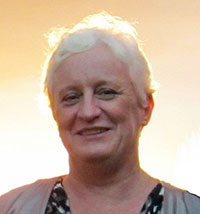 Carole Burrow. Geosciences, Queensland Museum, 122 Gerler Rd, Hendra, Brisbane, Queensland 4011, Australia. carole.burrow@gmail.com
Carole Burrow. Geosciences, Queensland Museum, 122 Gerler Rd, Hendra, Brisbane, Queensland 4011, Australia. carole.burrow@gmail.com
Carole Burrow is an Honorary Research Fellow in Geosciences at the Queensland Museum in Brisbane. She completed a Ph D on mid-Palaeozoic acanthodians of eastern Australia in 2001, and continues to specialize on this group of fossil fishes. She has been working with her coauthors on the Lower and Middle Devonian acanthodians of Scotland over the last couple of decades.

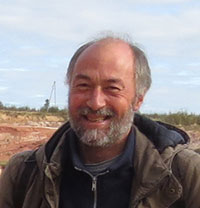 Jan den Blaauwen. University of Amsterdam, Science Park 904, 1098 XH, Amsterdam, Netherlands. J.L.denBlaauwen@uva.nl
Jan den Blaauwen. University of Amsterdam, Science Park 904, 1098 XH, Amsterdam, Netherlands. J.L.denBlaauwen@uva.nl
Jan den Blaauwen works at the University of Amsterdam in the research group Structural and Functional Plasticity of the Nervous System. Since 1977 he has been working, as a non-professional palaeontologist, on the histology and morphology of the Middle Devonian fishes (especially acanthodians) of the north of Scotland and related areas. Furthermore is he involved in several research projects involving the biostratigraphy of Devonian fishes.

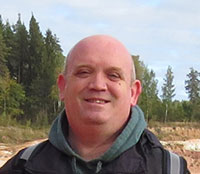 Michael Newman. Vine Lodge, Vine Road, Johnston, Haverfordwest, Pembrokeshire, SA62 3NZ, United Kingdom. ichthyman@btinternet.com
Michael Newman. Vine Lodge, Vine Road, Johnston, Haverfordwest, Pembrokeshire, SA62 3NZ, United Kingdom. ichthyman@btinternet.com
Michael Newman is a geology graduate from the University of Aberdeen. He is a non-professional palaeontologist specializing in the taxonomy and biostratigraphy of Palaeozoic fish particularly from the Old Red Sandstone Continent.

 Robert Davidson. 35 Millside Road, Peterculter, Aberdeen, AB14 0WG, United Kingdom. Bob.Davidson@nexencnoocltd.com
Robert Davidson. 35 Millside Road, Peterculter, Aberdeen, AB14 0WG, United Kingdom. Bob.Davidson@nexencnoocltd.com
Robert Davidson is a freelance oil well engineer who has been researching Scottish Devonian fossil sites for 25 years, and is an honorary research fellow at Aberdeen University Geology Department.
FIGURE 1. Type specimens of Scottish Middle Devonian diplacanthids: 1, Diplacanthus crassisimus (Duff, 1842) holotype NMS G.1891.92.333, from Tynet Burn, Moray; 2, Rhadinacanthus longispinus (Agassiz, 1844) holotype NMS G.1953.4.3, from Cromarty, Ross and Cromarty; 3, Homacanthus borealis holotype spine NMS G.1892.91.1, from Lybster, Caithness; 4, Diplacanthus tenuistriatus (Traquair, 1894) syntype NMS G.1891.92.340, from Gamrie, Banffshire. Scale bars equal 1 cm.

FIGURE 2. 1, Site map indicating the most important localities with Middle Devonian diplacanthids on northern Scotland; 2, biostratigraphic table of diplacanthid occurrences in the Orcadian Basin of northern Scotland.

FIGURE 3. Diplacanthus crassisimuss, NMS G.2014.4.29, from Edderton, Ross and Cromarty, showing surface morphology of spines: 1, complete specimen; 2, line drawing identifying various elements; 3, circumorbital bone; 4, occlusal bones; 5, procoracoid with ventral plate attached. Scale bars equal: 1 cm for 1, 2; 1 mm for 3-5. Abbreviations: a.f=anal fin web; a.fs=anal fin spine; ad.f=anterior dorsal finweb; ad.fs=anterior dorsal fin spine; adm.s=admedian spine; co.p=circumorbital plate; lt.sc=left scapula; lt.pelv.fs=left pelvic fin spine; oc.p=occlusal plate; pd.f=posterior dorsal finweb; pd.fs-=posterior dorsal fin spine; pelv.f=pelvic finweb; prepelv.s=prepelvic spine; proc=procoracoid; rt.p.fs=right pectoral fin spine; rt.pelv.fs=right pelvic fin spine; rt.sc=right scapula; v.p=ventral plate. Arrow indicates anterior.

FIGURE 4. Diplacanthus crassisimus, articulated specimens: 1-3, NMS G.2014.44.3 from Edderton, Ross and Cromarty: 1, complete specimen; 2, right occlusal plate; 3, left circumorbital and postorbital plates; 4,NMS G.2014.15.21, a ventrodorsally flattened specimen from Cruaday Quarry, Orkney, showing prepelvic spines; 5-7, NMS G.1891.99.10 from Tynet Burn, Moray: 5, head region; 6, impression of a displaced cheek, rotated 90° counterclockwise; 7, postorbital plate; 8-10, NHM OR.36582 from Tynet Burn, Moray: 8, complete specimen with head region ventrodorsally flattened, with articulated, displaced branchial region; 9, branchial region; 10, sketch of branchial region elements, rotated 90° clockwise. Scale bars equal: 1 cm for 1, 5, 8 and 5 mm for 2-4, 6, 7, 9. Abbreviations: ad.fs=anterior dorsal fin spine; bb=basibranchial; cb=ceratobranchials; ck.p=cheek plate; co.p=circumorbital plate; eb=epibranchials; oc=occlusal plate; pb=pharyngobranchials; prepelv.s=prepelvic spine; proc=procoracoid; scap=scapulocoracoid.

FIGURE 5. Diplacanthus crassisimus spine morphology and histology: 1, 2, NMS G.2014.4.29 from Blackpark, Ross and Cromarty; 1, anterior dorsal fin spine; 2, posterior dorsal fin spine; 3, pectoral spine of NMS G.1878.5.349 from Springpark, Caithness; 4, pectoral spine NMS G.2014.44.7 from west side of Sandside Bay, Caithness; 5, pectoral spine impression, Snaky Noust, Westray, Orkney (HY501.405); 6, longitudinal section of pelvic spine NMS G.2014.33.10 from Corbie Den, Banffshire; 7, transverse section of anterior dorsal fin spine NMS G.2014.33.9 from Corbie Den, Banffshire; 8, 9, transverse section of anterior dorsal fin spine NMS G.2014.33.11 from the south of East Murkle Bay, Caithness, with magnified image of same specimen; 10, transverse section NMS G.2014.44.2 of pectoral fin spine and bone of scapulocoracoid from Corbie Den, Banffshire. Scale bars equal 1 cm for 1-6 (1, 2 at same scale); 1 mm for 8, 10; 0.1 mm for 7, 9.

FIGURE 6. Drawings of serial transverse sections of the spines of Diplacanthus crassisimus. 1, sketch of NMS G.2014.15.7, from Edderton, Ross and Cromarty, showing the position of sections in 2-6; the sections run from the distal end to the base of each spine. 2, anterior dorsal fin spine (ad.fs); 3, anal fin spine (a.fs); 4, right pelvic fin spine (pelv.fs); 5, left pelvic fin spine; 6, left pectoral fin spine (p.fs). 7, Sollas sections of a prepelvic spine (prepelv.s) on NMS G.2014.44.4. Scale bars equal 1 mm.
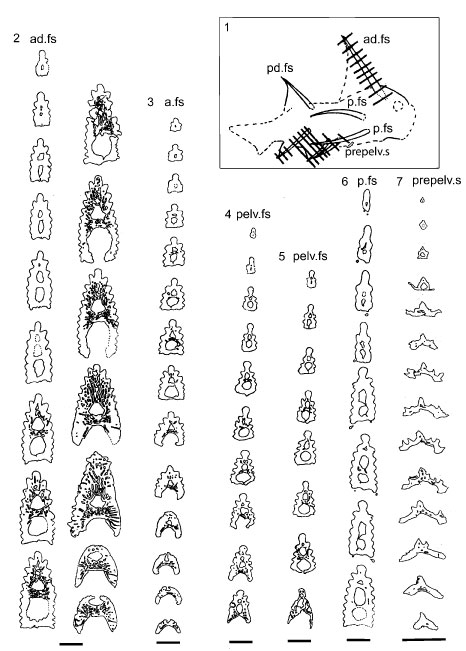
FIGURE 7. Diplacanthus crassisimus shoulder girdles. 1, NMS G.Canon Kyle no. 2 from Tynet Burn, Moray, showing ventral view of the shoulder girdle complexes; 2, NHM P.1357a from Tynet Burn, Moray, pectoral girdle region; 3, NHM P.22198 from Achanarras Quarry, Caithness, complete specimen; 4, NMS G.2014.44.3 from the Edderton, Ross and Cromarty; 5, 6, left shoulder girdle complex of NMS G.2014.4.30 from Cruaday Quarry, Orkney; 7, NMS G.2014.44.4 from the Edderton, Ross and Cromarty, natural transverse section through articulated uncompressed shoulder girdle region (prepelvic spines subsequently Sollas sectioned). Scale bars equal 1 cm.
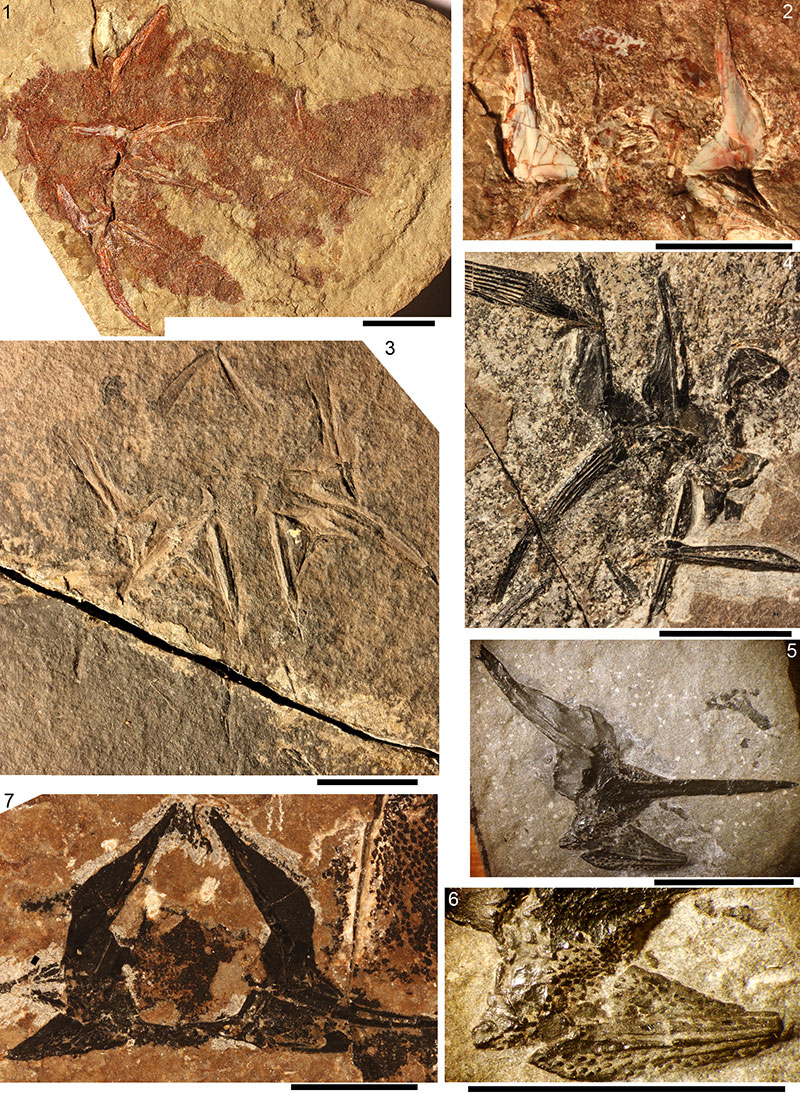
FIGURE 8. Diplacanthus crassisimus shoulder girdle thin section images. 1, 2, NMS G.2014.33.8 from west of Castletown Harbour, Caithness: 1, section through pectoral spine, pinnal plate, ?procoracoid, and scapulocoracoid; 2, transverse section through base of pectoral fin spine enclosed by pinnal plate and remnants of the endoskeletal coracoid plate; 3-5, section through admedian spine NMS G.2015.11.2 from Gamrie, Banffshire: 3, proximal end of admedian spine, inner bone base layer is the coracoid; 4, line drawing of reconstructed section; 5, scale-like ornament towards edge of admedian spine (area box in 4). Scale bars equal 1 mm in 1, 2, 4; 0.1 mm in 5.
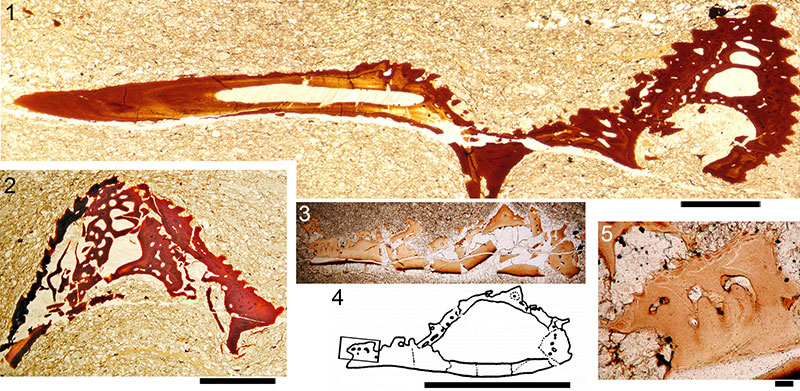
FIGURE 9. Line drawings of serial transverse sections through pectoral girdle elements of Diplacanthus crassisimus; sketch of whole specimen NMS G.2014.4.30 used to denote position of the sections shown in 2, 3 (mirror image sketch in latter). 1, serial destructive Sollas sections through admedian spine from west of Castletown, Caithness. 2, thin sections A-L through an isolated pectoral girdle complex NMS G.2014.33.8, from west of Castletown harbour. 3, Sollas sections 1-15 through an isolated juvenile pectoral girdle complex (without pectoral spine) from west of Castletown, Caithness. Abbreviations: adm.s=admedian spine; p.fs=pectoral fin spine; scap=scapula.
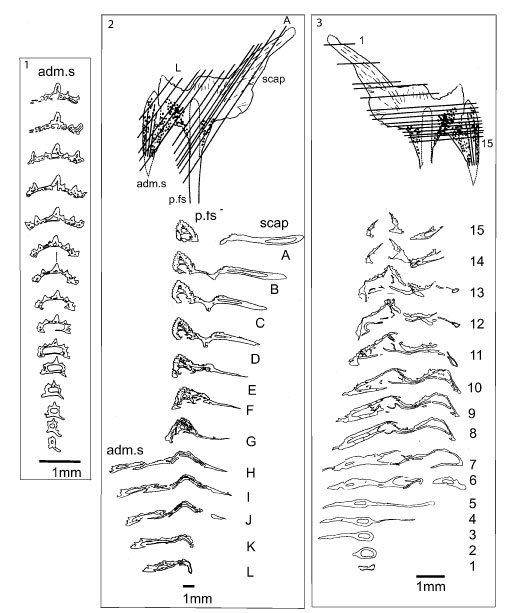
FIGURE 10. Reconstruction of the pectoral girdle of Diplacanthus crassisimus. 1, lateral view. 2, ventral view showing Miles' (1973a) interpretation on the left hand side of the fish and the authors’ revised version on the right hand side of the fish. Dark grey fill indicates dermal elements, light grey fill indicates endoskeletal elements.

FIGURE 11. Diplacanthus crassisimus from Gamrie, Banffshire, squamation. 1-5, NMS G.1882.60.17, articulated specimen showing scale morphologies: 1, the complete specimen, with A-C denoting areas of squamation shown in Figure parts 2-5: 2, 3, area A; 4, area B; 5, area C. 6, NMS G.1892.8.5, mid-body squamation. 7-11, scales slide NMS G.1882.60.17.1, Scanning Electron Micrographs (SEMs): 7, 8, crown and anterior views; 9, lateral view of scale pair; 10, basal view; 11, undersurface of crown (neck and base broken off). 12-15, scales slide NMS G.2015.11.3.1, SEMs: 12, 13, crown and posterior views; 14, 15, laterocrown and lateral views. Scale bars equal 1 cm for 1; 1 mm for 2-5; 0.2 mm for 6-11, 14, 15; 0.1 mm for 12, 13. Arrows directed anteriorly.
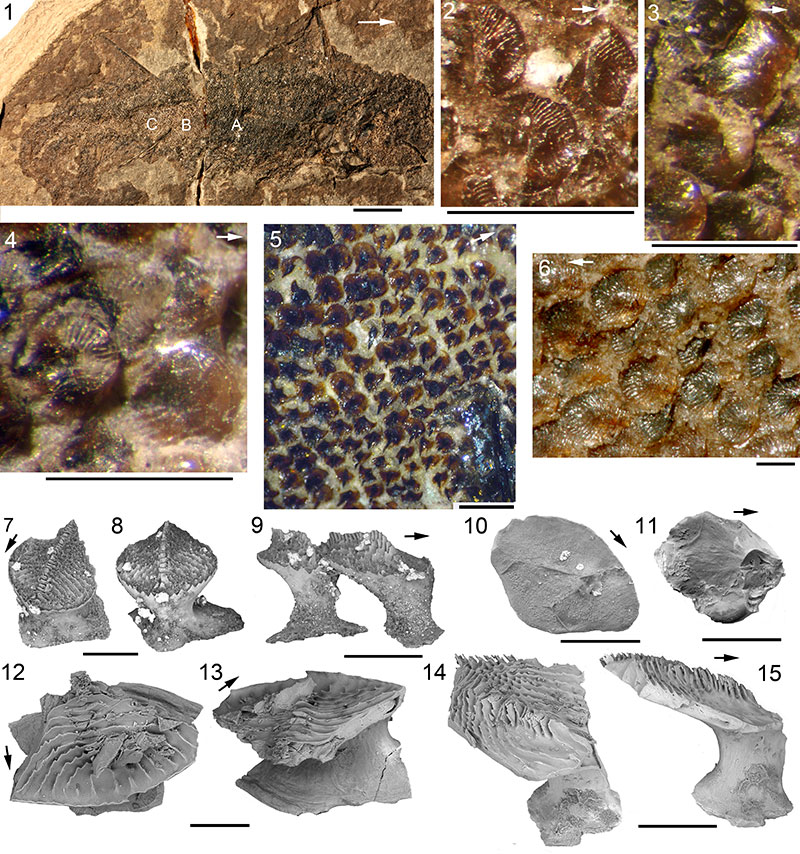
FIGURE 12. Diplacanthus crassisimus scale histology. 1-7, NMS G. 2014.33.10 from Corbie Den, Banffshire, thin sections of a patch of midflank scales: 1, group of scales sectioned in various orientations; 2, vertical longitudinal section; 3, crown horizontal section; 4, horizontal section through the base; 5, 6, vertical longitudinal sections through articulated scales; 7, crown horizontal section. 8, 9, NMS G.2015.11.3 from Gamrie, Banffshire, isolated midflank scales: 8, crown horizontal section; 9, vertical section through the base and lower neck, imaged with cross nicols. 10, 11, NMS G.2015.11.2 from Gamrie, Banffshire: 10, vertical longitudinal section; 11, vertical longitudinal section. Scale bars equal 0.1 mm. Abbreviations: cgz=crown growth zones; dt=dentine tubule; p=canal opening; pc=pore canal; spc=spiral canal. Arrows indicate anterior direction, where relevant.
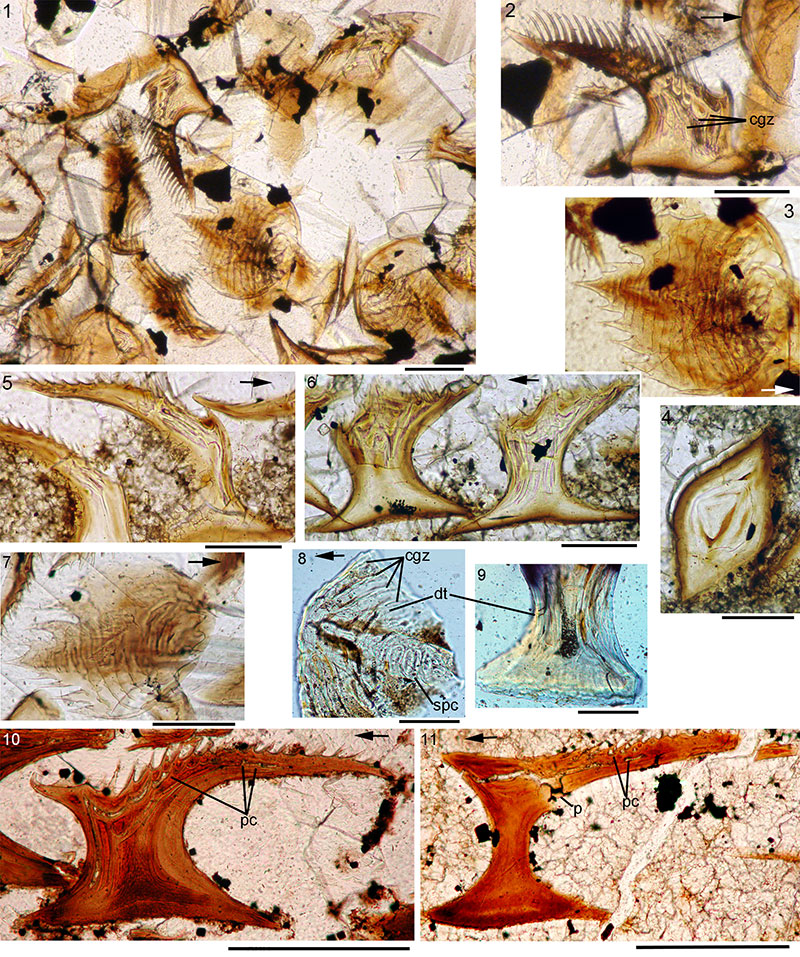
FIGURE 13. Diplacanthus tenuistriatus morphology. 1, NMS G.1897.55.2, counterpart of a headless large specimen from Achanarras Quarry, Caithness; 2, 3, NMS G.1897.55.1 (the part of NMS G.1897.55.2): 2, caudal fin, anal fin spine and fin web and right pelvic fin spine and fin web; 3, posterior dorsal fin spine and fin web; 4, NMS G.1870.14.144 from Tynet Burn, Moray, head and pectoral region. Scale bars equal 1 cm. Abbreviations: ad.fs=anterior dorsal fin spine; adm.s=admedian spine; ck.p=cheek plate; co.p=circumorbital plate; cor=coracoid; lt.sc=left scapula; lt.p.fs= left pectoral fin spine; oc=occlusal plate; p.p=pinnal plate; prepelv.s=prepelvic spines; rt.sc=right scapula.
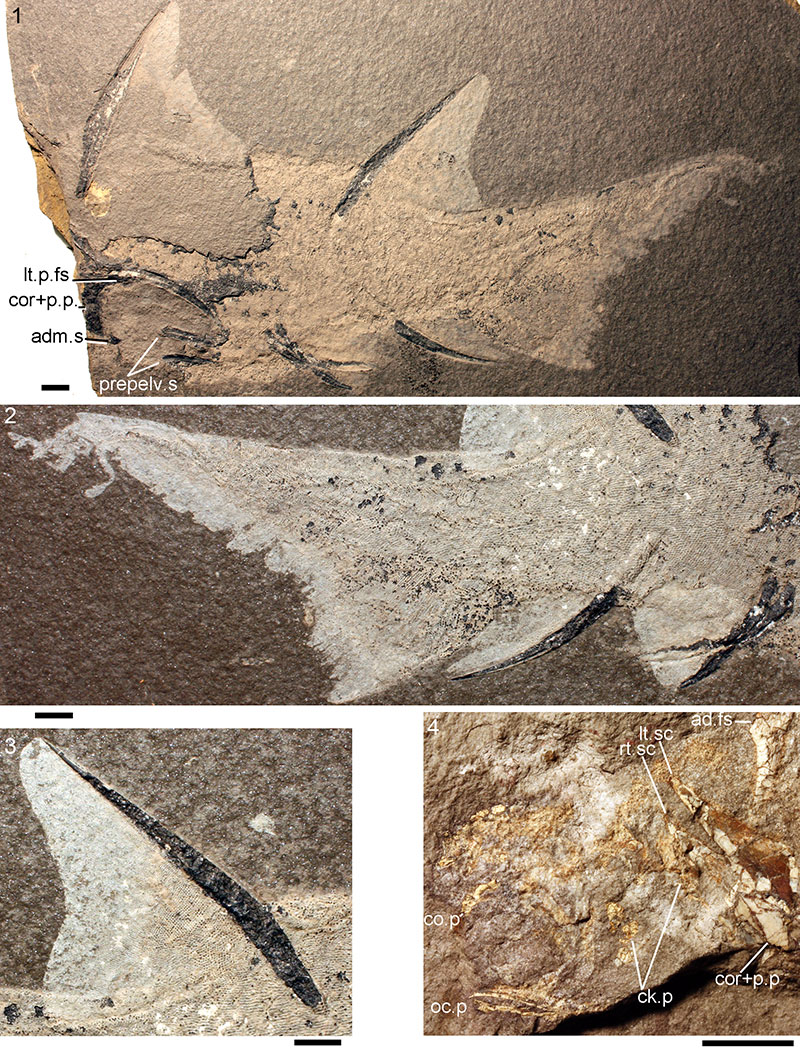
FIGURE 14. Diplacanthus tenuistriatus pectoral fin spines. 1-4, spine QM F58024 from Marwick, Orkney: 1, complete spine, dorsal surface; 2, ventral surface of spine; 3, recurved denticles on posterior edges of spine; 4, transverse natural fracture surface of distal part of spine, at point arrowed in (2); 5, NMS G.1901.153.1 from Appat Hill, Caithness; 6, NMS G.1898.163.2 from Birsay, Orkney; 7, NMS G.2014.4.18, from Marwick, Orkney, spine attached to pinnal plate. Scale bars equal 1 cm for 1, 2, 5-7; 1 mm for 3, 4.

FIGURE 15. Diplacanthus tenuistriatus anterior dorsal fin spines. 1, NMS G.2014.7.35 from Marwick, Orkney. 2-4, NMS G.2014.44.5 from Marwick, Orkney: 2, complete specimen in matrix; 3, magnified view of proximal exserted part; 4, magnified view of the same area. Scale bars equal 1 cm in 1-3; 1 mm in 4.
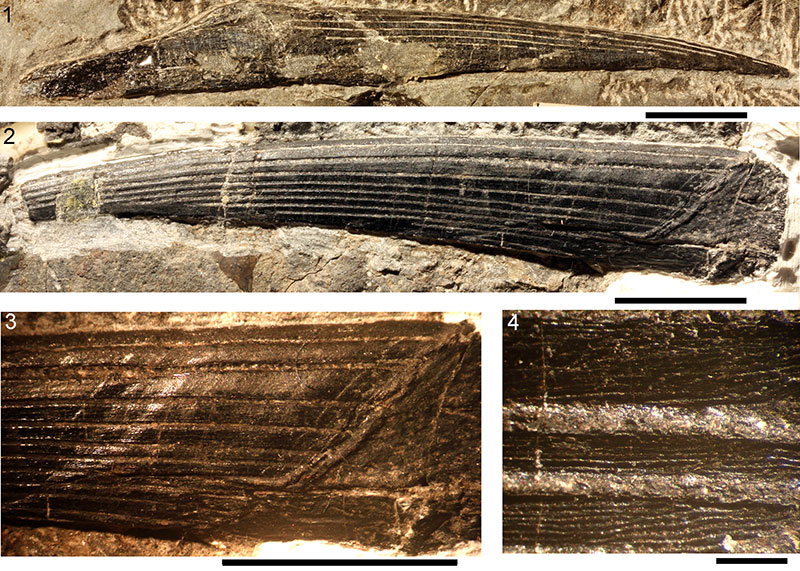
FIGURE 16. Diplacanthus tenuistriatus fin spine histology. 1-4, pectoral spine NMS G.2014.7.36 from Marwick, Orkney; 1-4, transverse section through the pectoral spine and the posterior end of the pinnal plate; 5, 6, anterior dorsal spine NMS G.2014.7.35 from Marwick Orkney: midspine transverse section. 7, NMS G.2014.33.1, midspine transverse section of anterior dorsal spine from North Ronaldsay, Orkney. Scale bars equal 1 mm in 1, 2, 5, 7; 0.1 mm in 3, 4, 6.
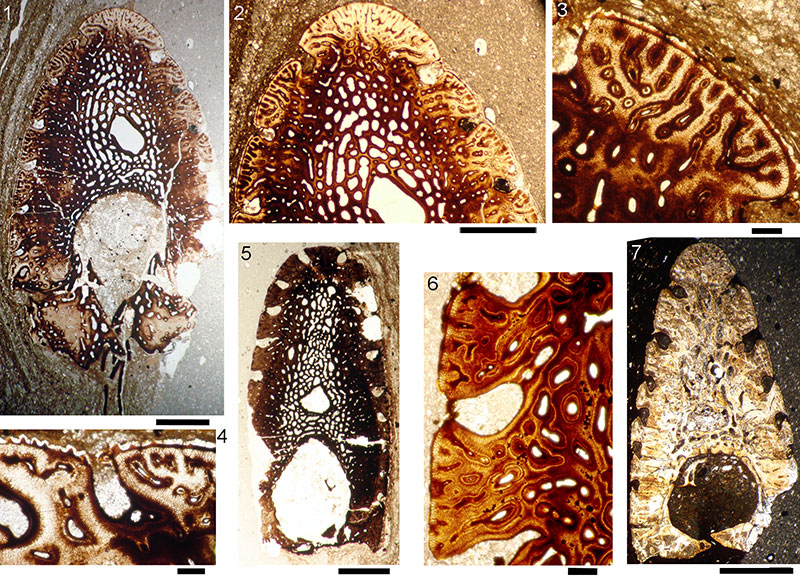
FIGURE 17. Drawings of transverse sections through Diplacanthus tenuistriatus pectoral and anterior dorsal fin spines. 1, 2, pectoral fin spine NMS G.2014.7.36 from Marwick, Orkney: 1, through pectoral spine and posterior end of pinnal plate; 2, slightly distal to the latter section; 3, 4, anterior dorsal fin spine NMS G.2014.7.35 from Marwick, Orkney; 3, midspine; 4, slightly proximal to latter section. Scale bars equal 1 mm. Abbreviations: cc=central pulp canal; e=enameloid; gl=growth line; ost=osteodentine; p.p=pinnal plate; uc=upper longitudinal canal. Arrows point to junction between pectoral fin spine and pinnal plate.
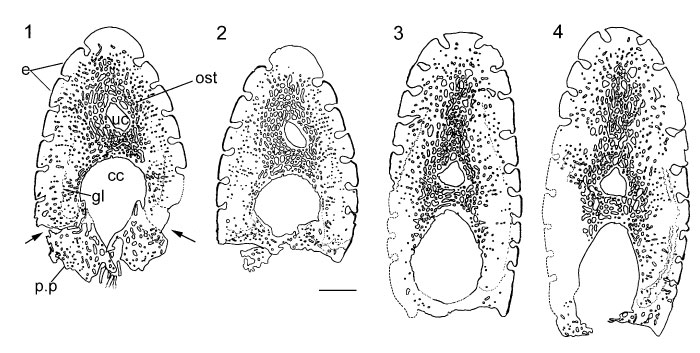
FIGURE 18. Diplacanthus tenuistriatus isolated shoulder girdle complexes. 1-4, NMS G.2014.15.21 from Marwick, Orkney: 1, external surface of scapulocoracoid, pectoral fin spine, pinnal plate and admedian spine; 2, admedian spine; 3, 4, scale-like ornament on pinnal plate; 5, NMS G.2014.15.22 from Marwick, Orkney, internal surface; 6-9, transverse sections of NMS G.2014.4.20 from Marwick, Orkney: 6, pinnal plate; 7, multiple odontode on plate; 8, scale-like ornament; 9, transverse section through pinnal plate, pectoral fin spine base, scapulocoracoid and perichondral bone sheet; 10, 11, NMS G.2014.4.27 from Flashes, Hoy, Orkney, transverse section through base of admedian spine and inner perichondral bone sheet; 10, whole width; 11, scale-like ornament in groove. Scale bars equal 1 cm in 1, 5; 5.0 mm in 2; 1.0 mm in 3, 4, 6; 0.5 mm in 9, 10; 0.1 mm in 7, 8, 11; 0.05 mm in 4.
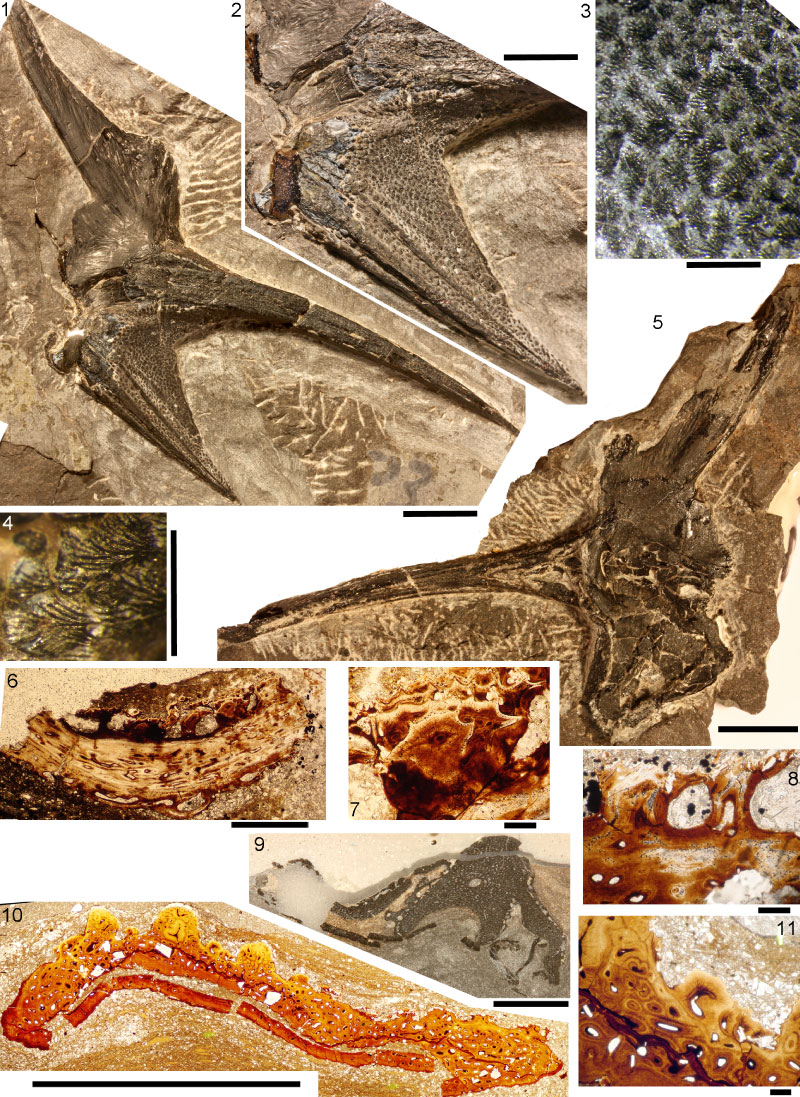
FIGURE 19. Drawings of serial sections throughDiplacanthus tenuistriatus shoulder girdle complexes from Marwick, Orkney. 1, schematic drawing of the external view of shoulder girdle complex NMS G.2014.4.21, showing levels at which transverse sections were made. 2, schematic drawing of the inner view of complex NMS G.2014.15.22. A2-F1 is the section series through the admedian spine on NMS G.2014.4.27; I1 is a section through the pectoral fin base enclosed by surrounding plates on NMS G.2014.4.27; I2, J2B, and J2A are sections through the admedian spine, pinnal plate, pectoral fin, base of scapulocoracoid and perichondral bone of the coracoid of NMS G.2014.4.20; 10A and 10B are sections through the girdle complex NMS G.2014.4.23; K2, L1, M2 and O1 are serial sections through the scapulocoracoid and associated structures of NMS G.2014.20.20. Scale bars equal 5 mm. Anatomical abbreviations: adm.s=admedian spine; pch.b=perichondral bone layer; p.fs=pectoral fin spine; p.p=pinnal plate; sc=scales; scap=scapula; scap.c=central pulp cavity of scapula shaft.
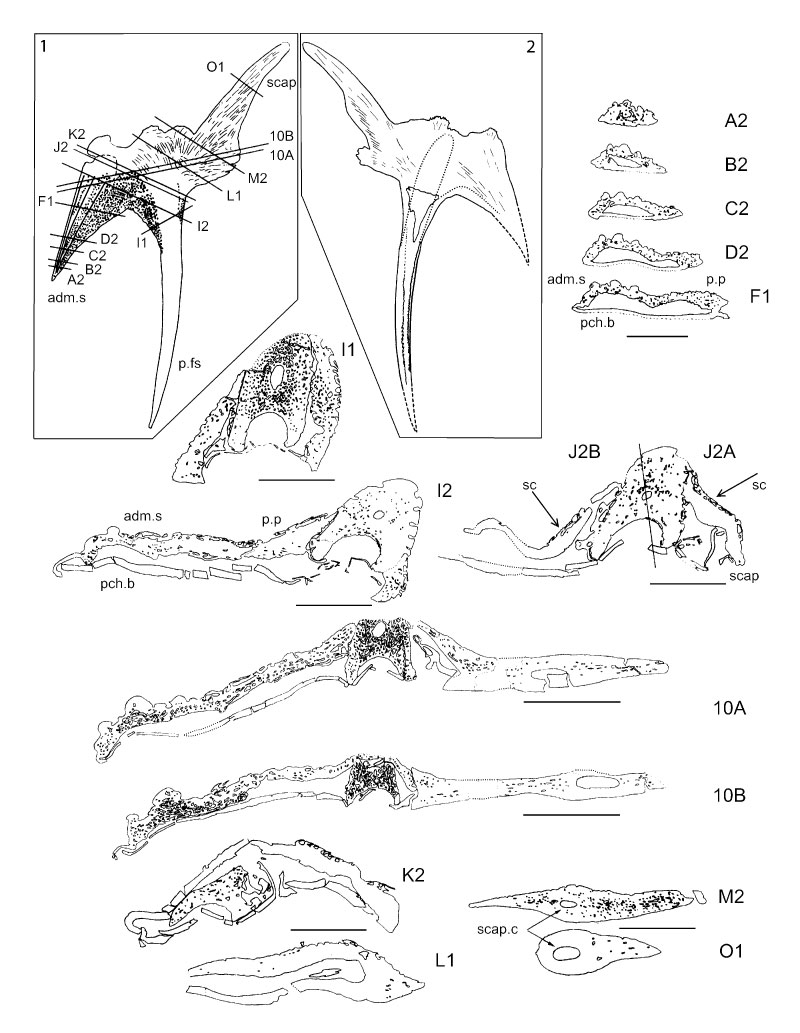
FIGURE 20. Reconstruction of the shoulder girdle region in Diplacanthus tenuistriatus. 1, lateral view. 2, ventral view. Dark grey fill indicates dermal elements, light grey fill indicates endoskeletal elements.
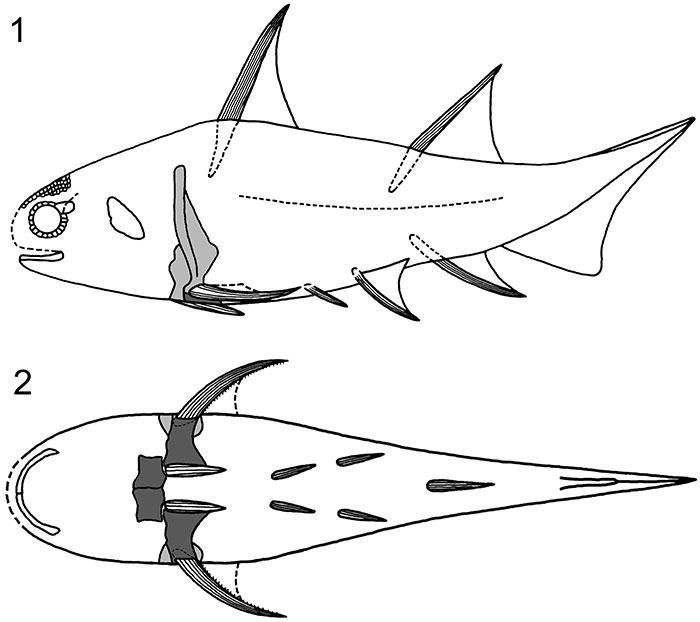
FIGURE 21. Diplacanthus tenuistriatus specimens from Achanarras Quarry, Caithness, squamation and scale histology. 1, NMS G.1897.55.2 (Figure 13.1), impression of squamation anterior to base of posterior dorsal fin spine; 2, 3, NMS G.1897.55.1 (Figure 13.2), squamation above the anal fin, scale crown detail partly obscured by matrix; 4-9, NMS G.1897.55.1, serial sections from patch of midflank squamation: 4, 5, vertical transverse section of scale; 6, 7, vertical longitudinal section of scale; 8, vertical longitudinal section of scale; 9, horizontal section near the level of the base/neck rim of scale. Scale bars equal 1 cm in 1; 1 mm in 2-3; 0.1 mm in 4-9. Arrows indicate anterior direction, where relevant.
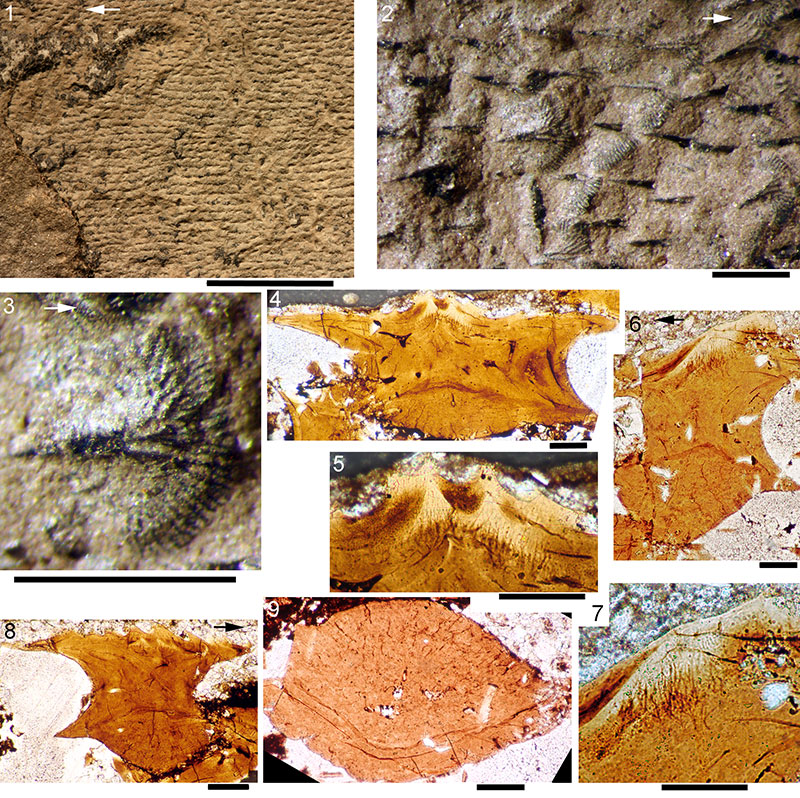
FIGURE 22. Diplacanthus tenuistriatus squamation and histology of scales from Tynet Burn and Gamrie. 1-8, NMS G.Canon Kyle no. 1 from Tynet Burn: 1, postpectoral-caudal peduncle region; 2, mid-body squamation; 3, scale crown; 4, vertical transverse section of scale from caudal region (area A); 5, vertical longitudinal section of scale from area A; 6, horizontal section through crown base, scale from posterior to ad.fs (area B); 7, mid-crown horizontal section, area B; 8, upper crown horizontal section, area B. 9-16, NMS G.1892.8.9 from Gamrie, Banffshire: 9, complete specimen; 10-16, sections of scales from upper flank area between ad.fs and pd.fs (area A) and lower flank in front of a.fs (area B); 10, calcified cartilage globules, posterior end of area B; 11, horizontal section through scale neck, posterior end of area B; 12, vertical longitudinal section, area A; 13, vertical transverse section, area A; 14, vertical longitudinal section, area A; 15, transverse section, area A; 16, vertical oblique section, area A. Scale bars equal 1 cm in 1, 9; 1 mm in 2-3; 0.1 mm in 4-8, 10-16. Abbreviations: a.fs=anal fin spine; pd.fs=posterior dorsal fin spine. Arrows indicate anterior direction, where relevant.
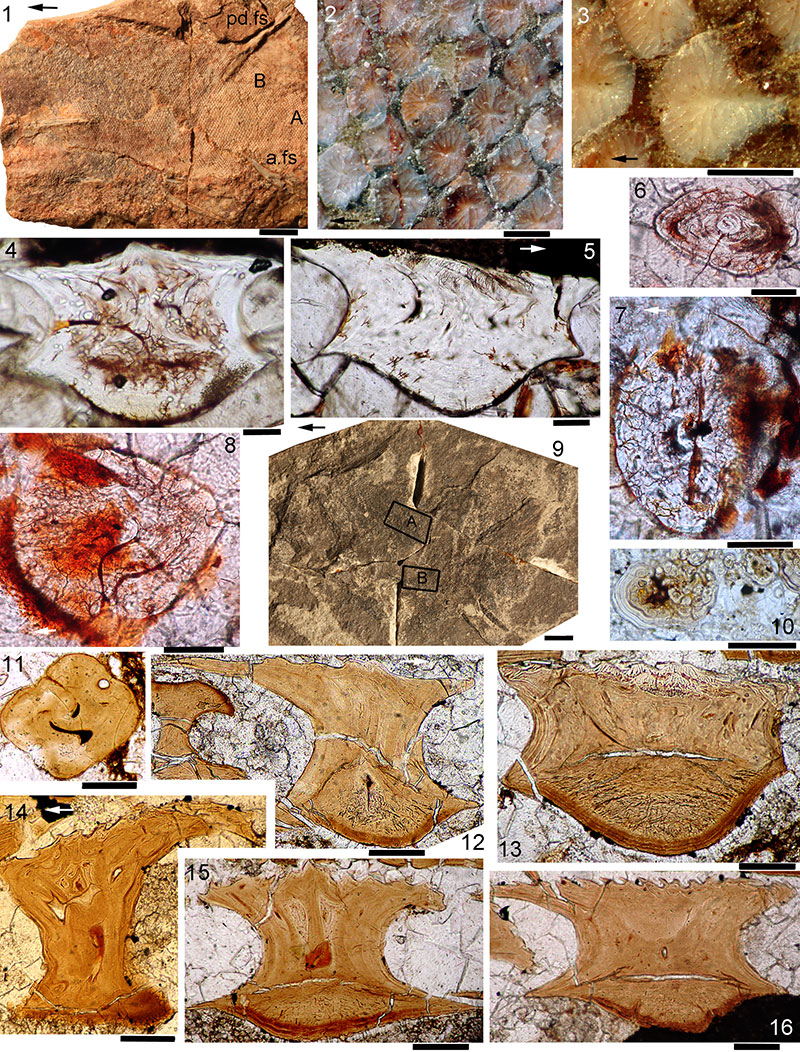
FIGURE 23. Scanning Electron Micrographs of Diplacanthus tenuistriatus scales. 1-4, NMS G.Canon Kyle no. 1 from Tynet Burn, Moray, scales slide NMS G.Canon Kyle no. 1.1, from dorsal side posterior to ad.fs, SEMs: 1, anterior view with broken crown; 2, 3, posterocrown and anterocrown views with end of posterior crown broken off; 4, posterior view. 5-13, NMS G.1892.8.9 from Gamrie, Banffshire, SEMs: 5, 6, 13-16, scales slide NMS G.1892.8.9.17: 5, crown view; 6, anterocrown view; 13, patch of scales in matrix, crown view; 14, crown view; 15, lateral view; 16, posterior view. 7-12, scales slide NMS G.1892.8.9.18: 7, crown view; 8, anterior view; 9, posterior view; 10, anterolateral view; 11, 12, posterobasal view and closeup of base surface. Scale bars equal 1 mm for 13; 0.3 mm for 1-11, 14-16; 0.1 mm for 12.
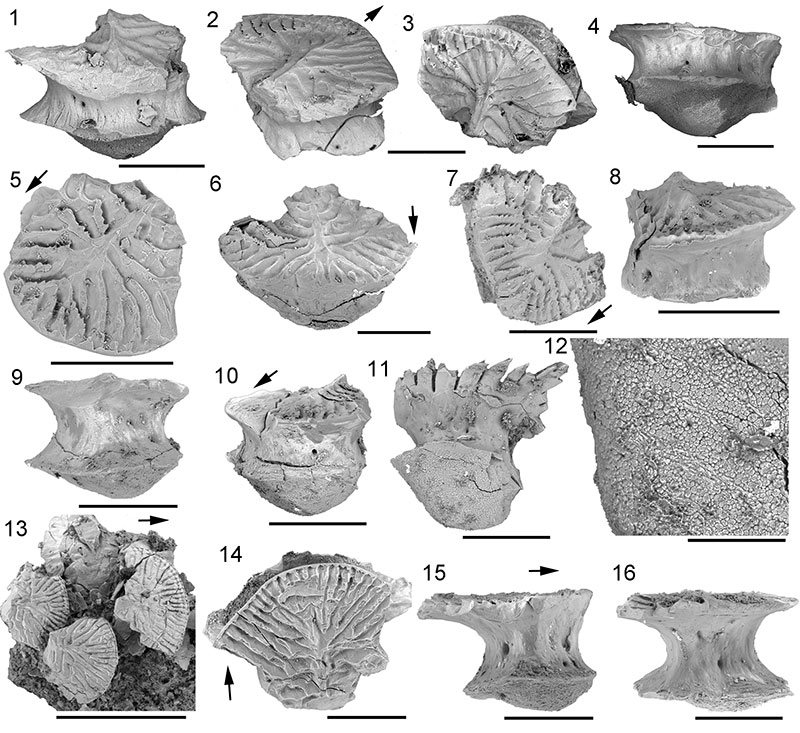
FIGURE 24. Rhadinacanthus longispinus from Gamrie, Banffshire, general morphology. 1, NMS G.1891.92.338; 2, 3, NHM P.4041 from Gamrie, part and counterpart respectively. Scale bars equal 1 cm.
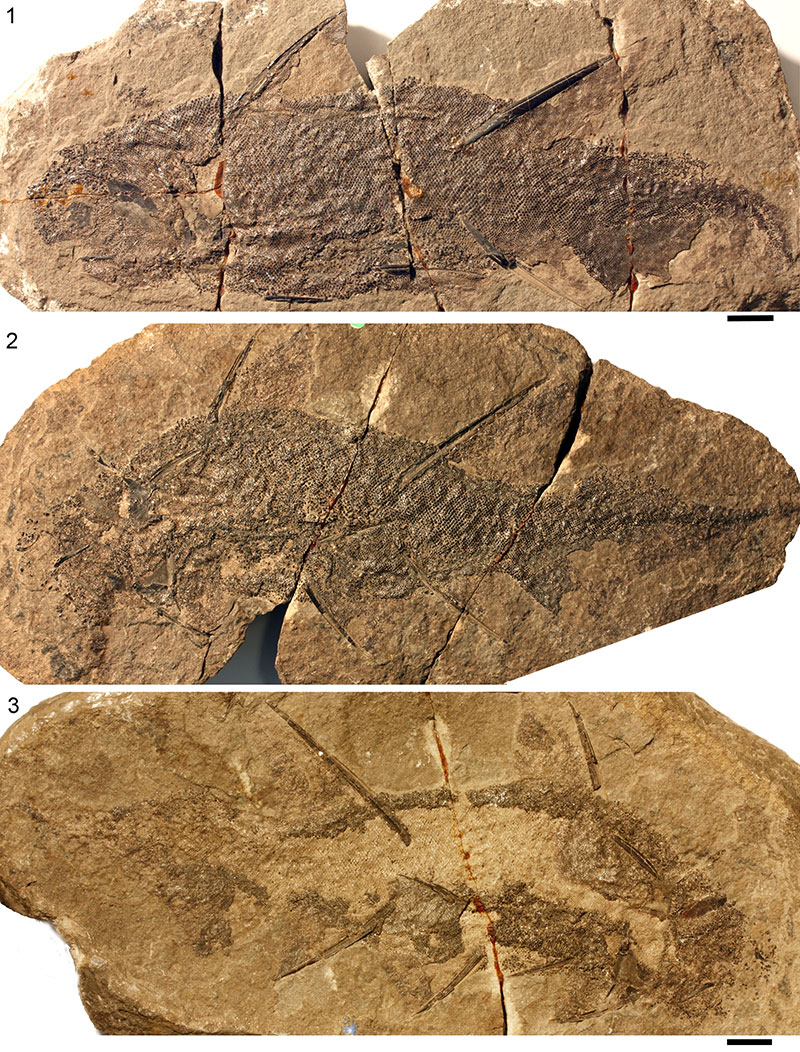
FIGURE 25. Rhadinacanthus longispinus head morphology. 1, 2, NMS G.1891.92.338 from Gamrie, Banffshire; 1, head region; 2, magnified image of sensory line scales; 3, NMS G.1892.8.15 from Gamrie, Banffshire, head region. 4, 5, NHM OR.43276 from Tynet Burn, Moray: 4, complete specimen, head to left; 5, internal surface of right cheek plate, long anterior circumorbital bone, polygonal tesserae on tectal region. 6, NMS G.1892.8.10 from Gamrie, head region. Scale bars equal 1 cm for 1, 3, 4, 5, 6; 1 mm for 2. Abbreviations: ck.p=cheek plate; co.p=circumorbital plate; e=eye stain; oc.p=occlusal plate; so.sl=supraorbital sensory line. Arrows indicates anterior direction.
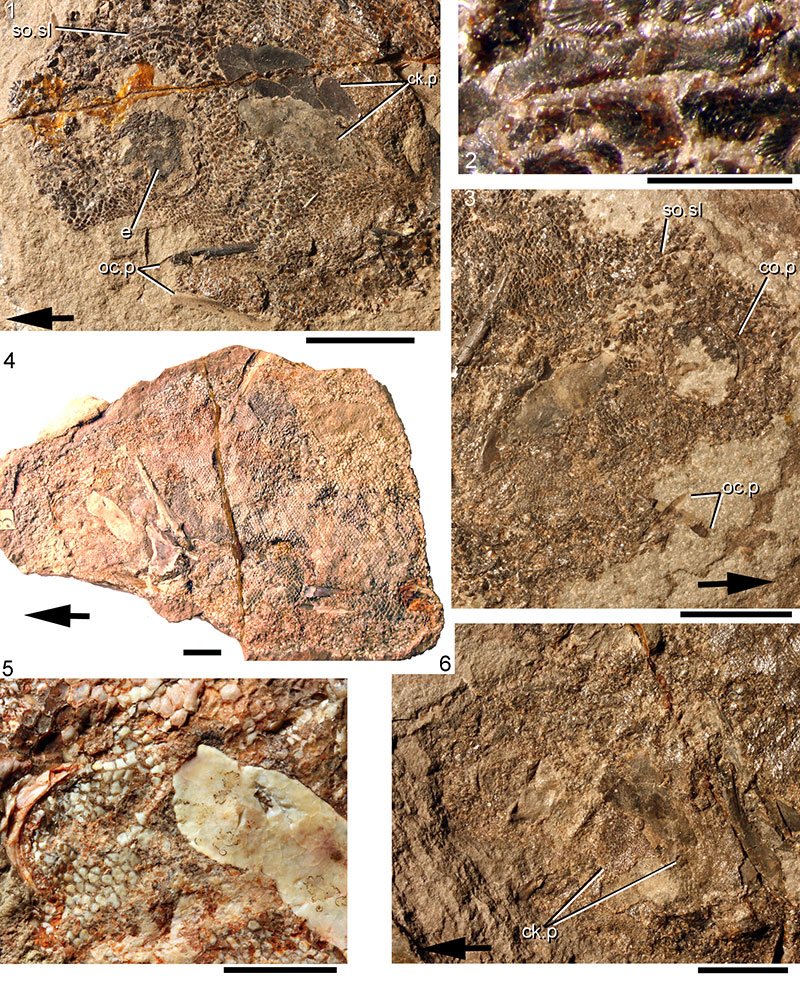
FIGURE 26. Rhadinacanthus longispinus spine morphologies. 1, 2, isolated anterior dorsal fin spine of NMS G.2014.33.4 from Marwick, Orkney: 1, whole spine; 2, long insertion zone showing fine parallel ribs; 3, posterior dorsal fin spine of NMS G.2014.33.7 from Marwick, Orkney; 4, anal fin spine of NMS G.1859.33.703 from Thurso, Caithness; 5, pectoral fin spine of NMS G.1968.5.2 from Taldale Quarry, Caithness; 6, denticulated posterior of pectoral fin spine on specimen NMS G.1870.14.143 from Gamrie, Banffshire. Scale bars equal 1 cm. Abbreviations: p.fs=pectoral fin spine; scap=scapula.
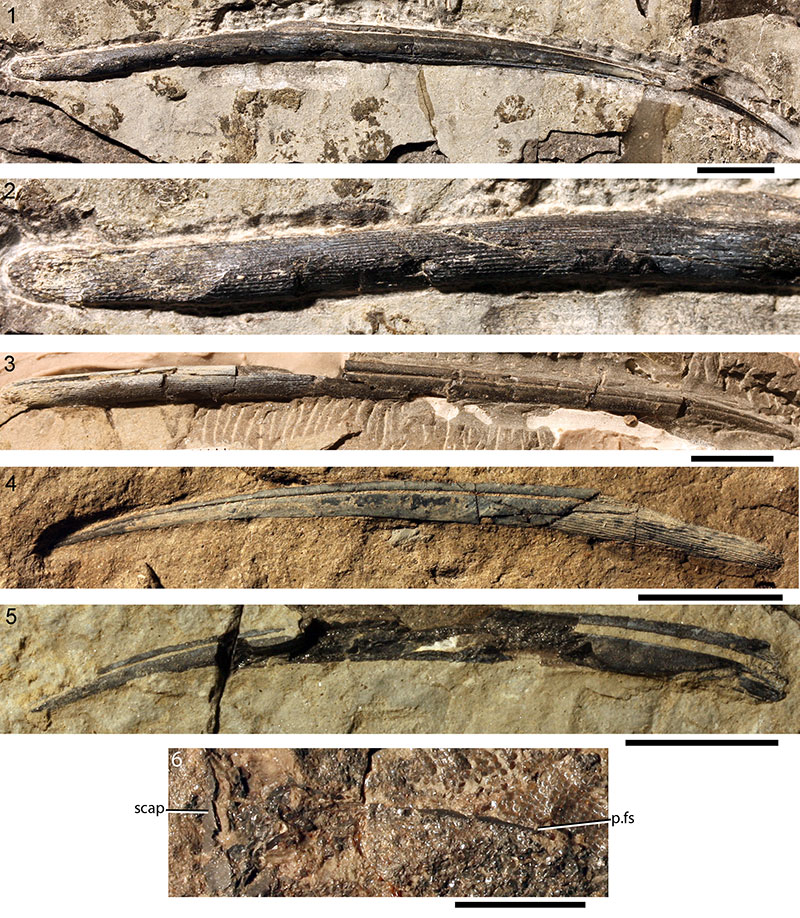
FIGURE 27. Rhadinacanthus longispinus dorsal spine histology. 1, 2, transverse section of anterior dorsal fin spine NMS G.2015.11.1 from Broad Taing, Orkney: 1, whole section indicated by white line; 2, magnified area; 3-5, transverse sections of posterior dorsal fin spine NMS G.2014.4.33 from the slates west of East Murkle Bay, Caithness (Mey subgroup): 3, section through insertion area; 4, 5, section through exserted part of spine; 6, transverse section of posterior dorsal spine NMS G.2014.33.2 from North Ronaldsay (Rousay Beds). Scale bars equal 1 mm in 1, 3, 4, 6; 0.1 mm in 2, 5.
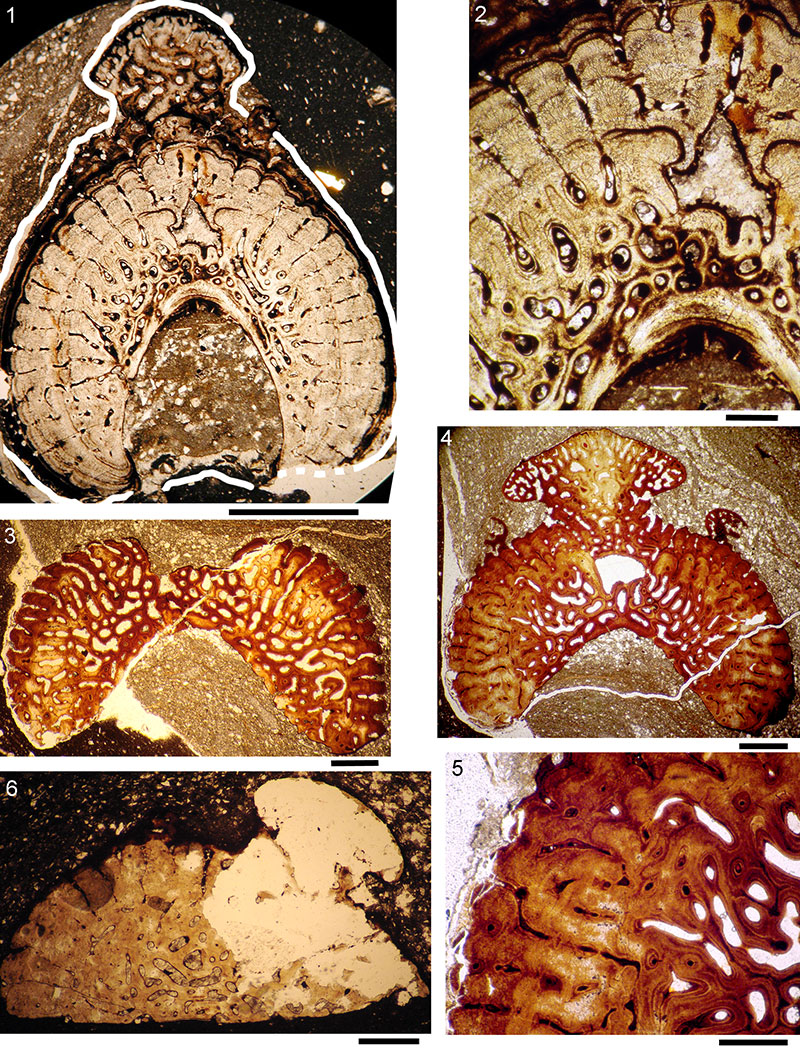
FIGURE 28. Rhadinacanthus longispinus paired and anal spines histology. 1-5, sections of spines on articulated fish NMS G.2014.4.32 from Achanarras; 1, transverse section of pectoral fin spine just distal to insertion area; 2, more distal transverse section of pectoral fin spine; 3, 4, longitudinal section of proximal half of anal fin spine; 5, longitudinal section of distal half of pelvic fin spine; 6, 7, NMS G.2014.44.1 from Cromarty, Ross and Cromarty, section through partial articulated specimen; 6, transverse section of pelvic fin spine; 7, transverse section of prepelvic spine. Scale bars equal 1 cm in 3; 0.5 mm in 1-2, 5-7; 0.1 mm in 4.
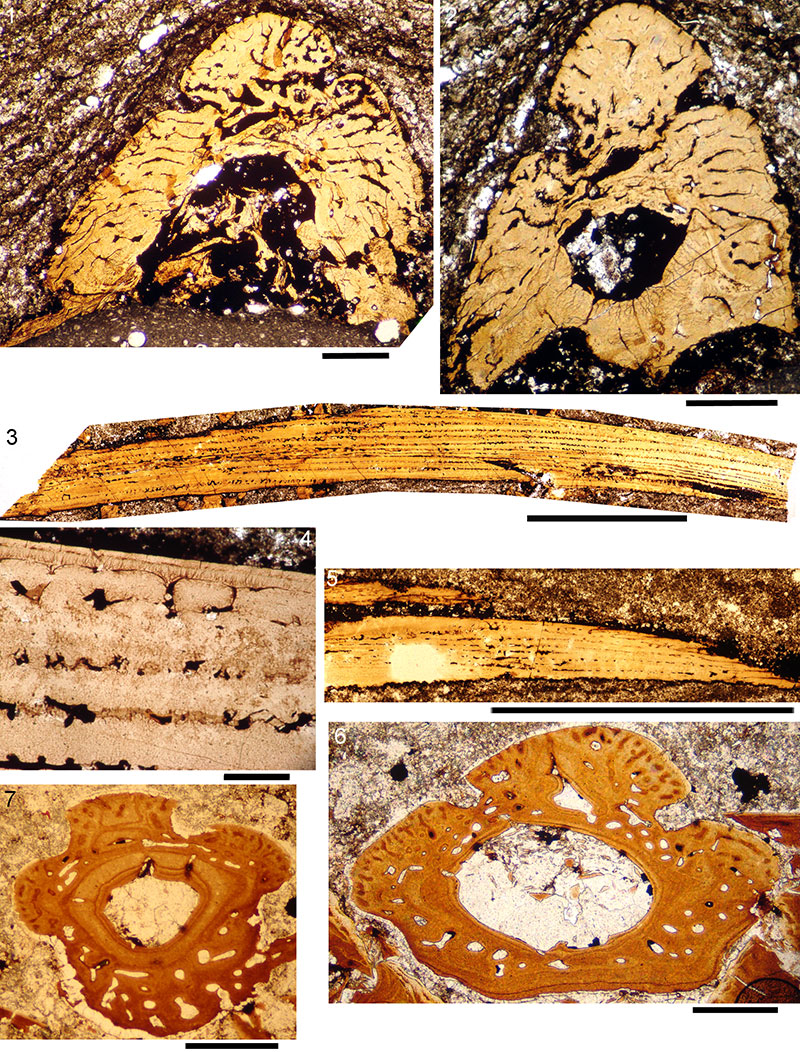
FIGURE 29. Rhadinacanthus longispinus, from a small bonebed (NMS G.2014.15.1 is a sample) at Clardon Haven, Caithness, spine histology. Drawings of Sollas serial sections of various spines from juvenile fish. Abbreviations: adm.s=admedian spine; ad.fs=anterior dorsal fin spine; a.fs=anal fin spine; pelv.fs=pelvic fin spine; p.fs=pectoral fin spine; prepelv.s=prepelvic spine. Length given for each spine.
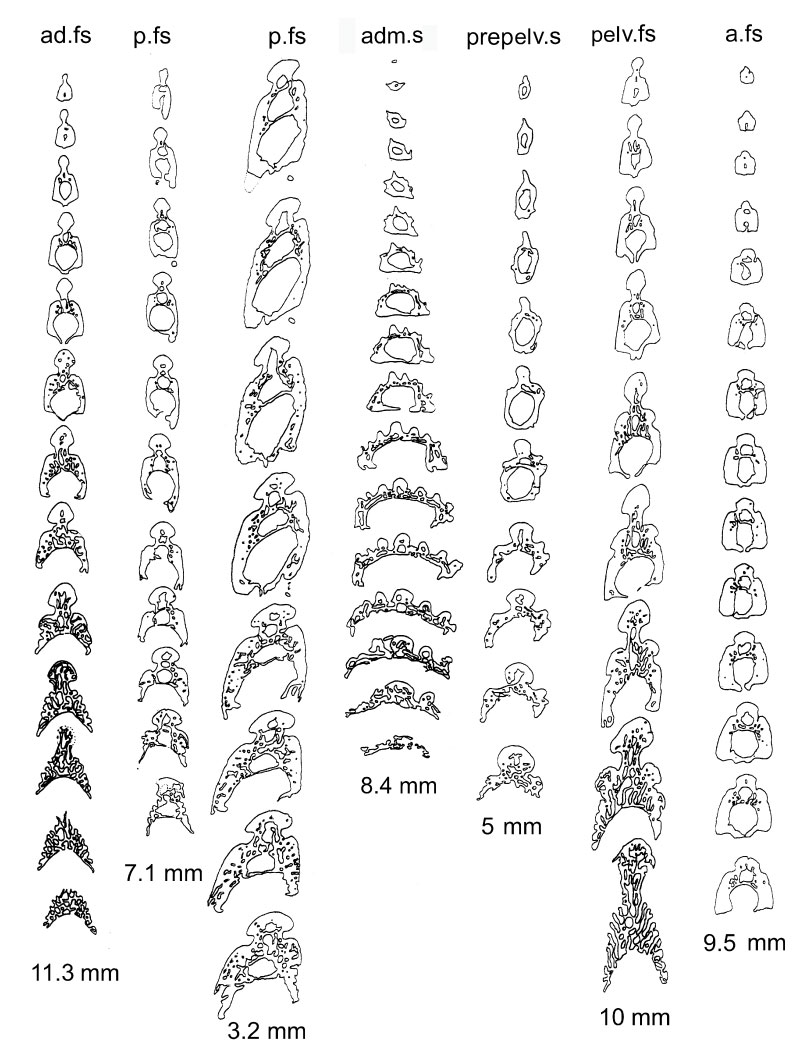
FIGURE 30. Rhadinacanthus longispinus median fin spines from mature fish, transverse section drawings. 1, 2, posterior dorsal spine NMS G.2014.4.33 from the slates west of East Murkle Bay, Caithness: 1, spine showing position of sections; 2, sections 1-8. 3, section of posterior dorsal spine NMS G.2014.33.2 from North Ronaldsay. 4, section of anterior dorsal spine NMS G.2014.11.1 from Broad Taing, Orkney. Scale bars equal 1 cm in 1; 5 mm in 2; 1 mm in 3, 4.
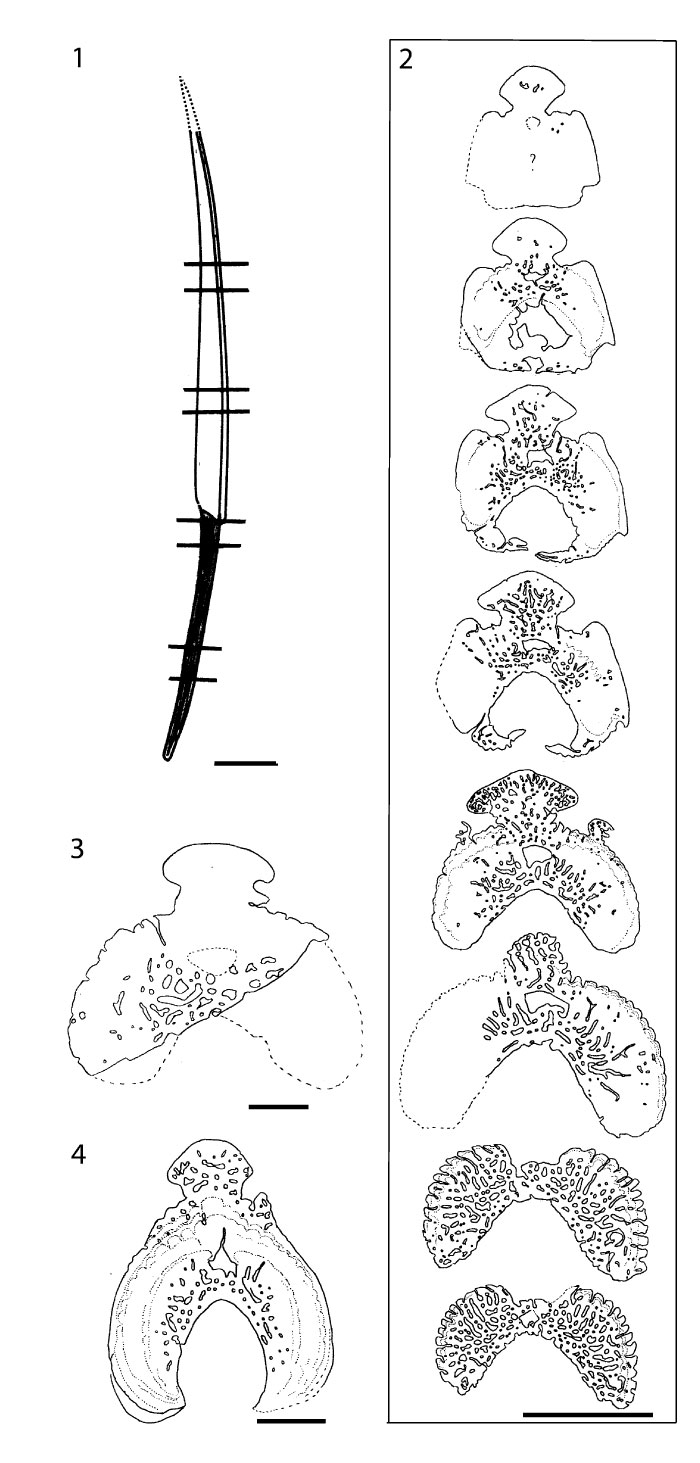
FIGURE 31. Rhadinacanthus longispinus NHM P.4041, from Gamrie, Banffshire, shoulder girdles; 1, 2, pectoral region and head on the part (anterior to right); 3, magnified view of the impression of the admedian spine; 4, 5, pectoral region and head on the counterpart (anterior to left). Scale bars equal 1 cm. Abbreviations: adm.s=admedian spine; ck.p=cheek plate; co.p=circumorbital plate; cor/adm.s=coracoid attached to base of admedian spine; lt.sc=left scapula; lt.p.fs= left pectoral fin spine; oc.p=occlusal plate; p.p=pinnal plate; rt.p.fs=right pectoral fin spine; rt.sc=right scapula; v.p=ventral plate.
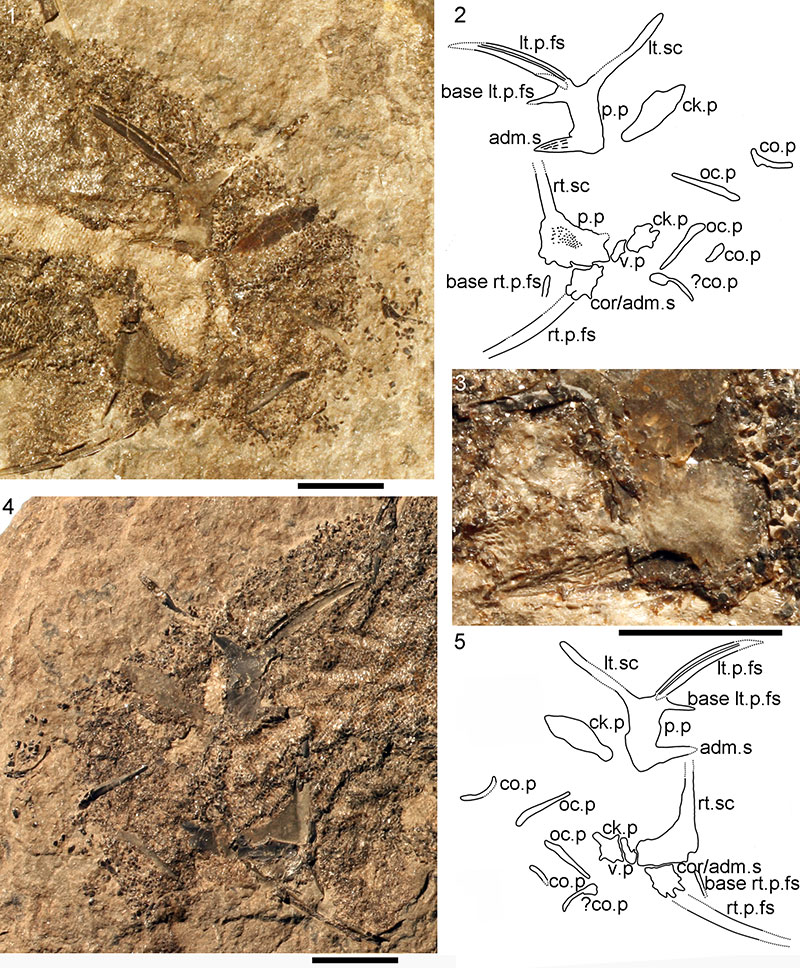
FIGURE 32. Rhadinacanthus longispinus. 1-2, NMS G.1966.49.9 from Orkney, pectoral region and head; 3-4, NMS G.1891.92.334 from Orkney, pectoral region and head; 5-7, isolated scapula NMS G.2014.15.2 from Marwick: 5, ?medial view; 6, ?lateral view, with 7, area with remnants of pinnal plate fused to scapula base. Scale bars equal 1 cm. Abbreviations: adm.s=admedian spine; lt.sc=left scapula; lt.p.fs= left pectoral fin spine; p.p=pinnal plate; rt.p.fs=right pectoral fin spine; rt.sc=right scapula.
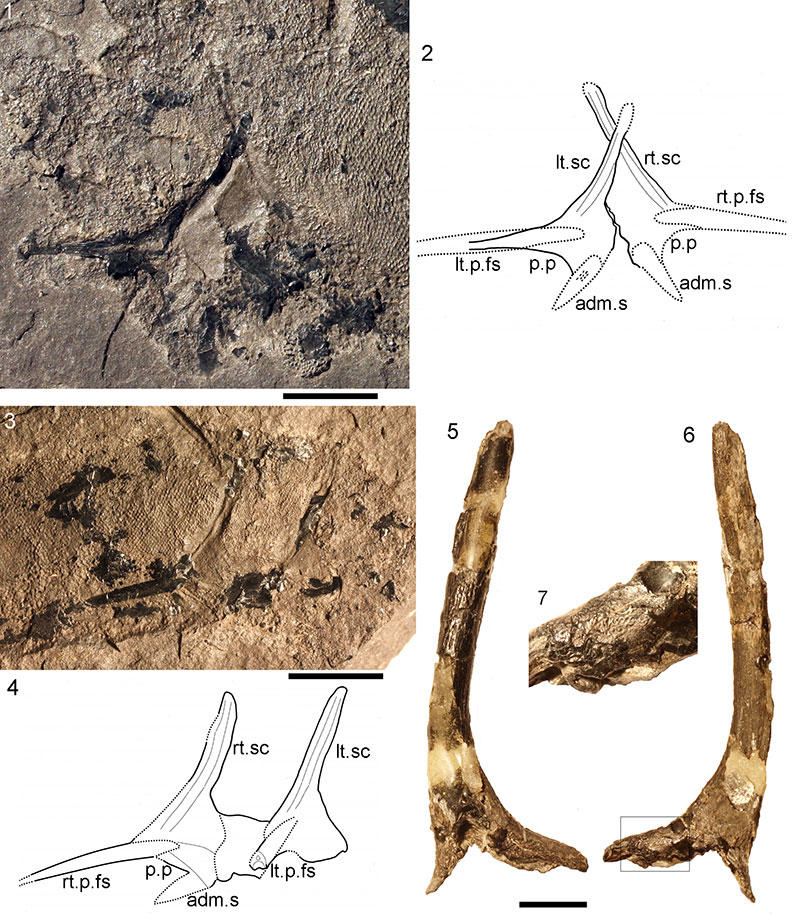
FIGURE 33. Reconstructions of Rhadinacanthus longispinus. 1, lateral view. 2, ventral view. Dark grey fill indicates dermal elements, light grey fill indicates endoskeletal elements.
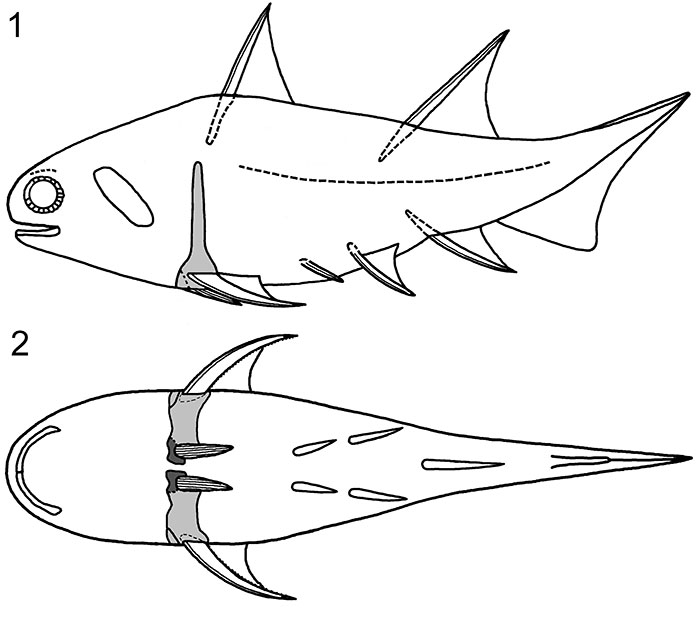
FIGURE 34. Rhadinacanthus longispinus squamation types on different body areas. 1-3, NHM OR.43276 from Tynet Burn, Moray; 1, surrounding scapula shaft; 2, anterior dorsal fin web; 3, mid-flank. 4, NMS G.1892.8.13 from Gamrie, Banffshire, mid-flank; 5, NMS G.2002.59.142pt from Cushnie Burn, Banffshire, mid-flank; 6-10, NHM P.11760 from Gamrie, Banffshire, 6, complete specimen with A, B, C areas magnified in the following images; 7, midflank with lateral line (area A); 8, below lateral line (area A); 9, tail (area B); 10, posterior dorsal fin web (area C). Scale bars equal 1 cm in 1-2, 6, 9-10; 1 mm in 3-5, 7, 8. Abbreviations: fw sc=fin web scales; ll sc=lateral line scales; sc=body scales; scap=scapula shaft, tess=head tesserae.
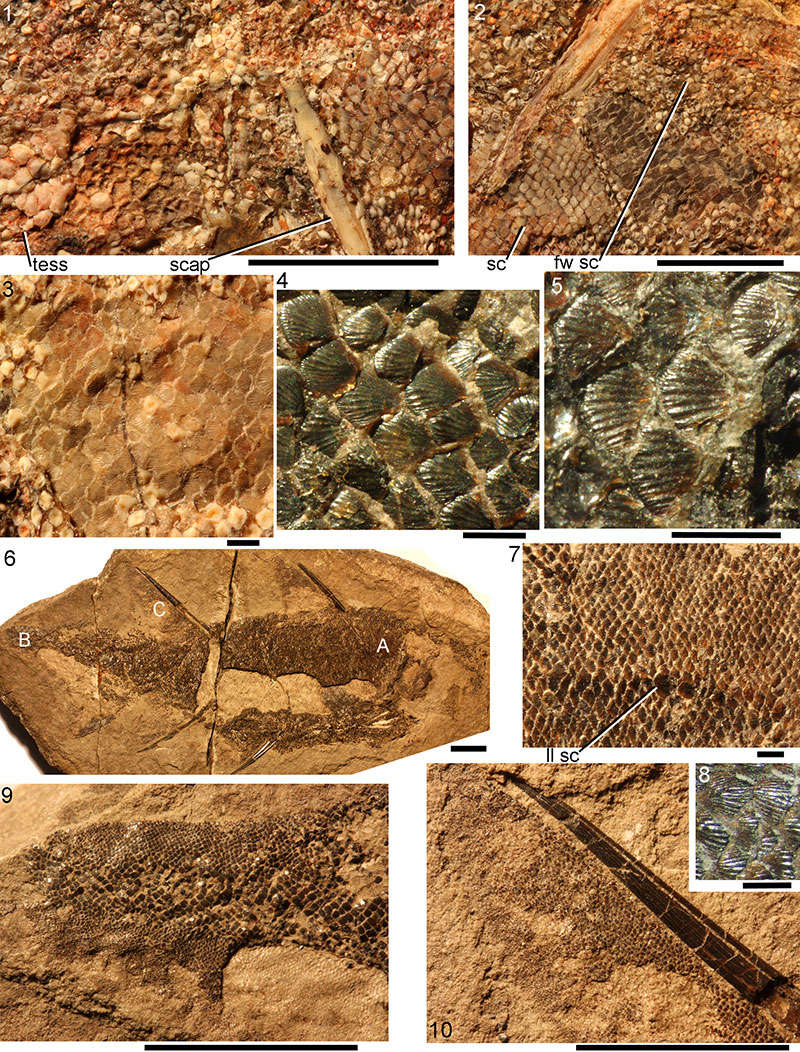
FIGURE 35. Rhadinacanthus longispinus, scanning electron micrographs of scales. 1-4, scales slide NMS G.1892.8.17.1 from Gamrie, Banffshire: 1, 2, crown view of patch of articulated scales, and closeup of scale; 3, lateral view; 4, anterior view. 5-7, scales slide NMS G.1870.14.143.1 from Gamrie, Banffshire: 5, laterocrown view; 6, lateral view; 7, scales from each side of body, stuck together base to base, in posterior view. 8-12, scales slide NMS G.1892.8.15.1 from Gamrie, Banffshire: 8, crown view; 9, crown view; 10, basal view; 11, lateral view; 12, anterior view. Scale bars equal 0.3 mm. White adhesions on scale bases are pyrite crystals. Arrows indicate anterior.
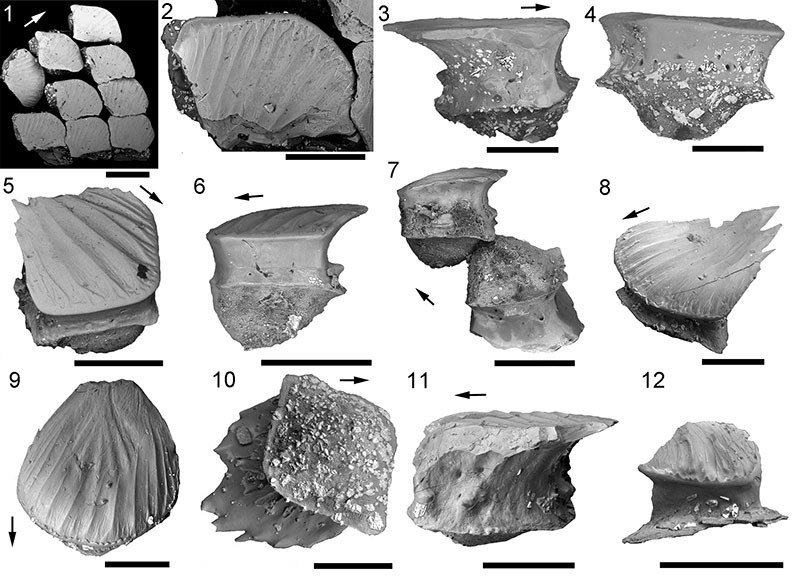
FIGURE 36. Rhadinacanthus longispinus NMS G.2014.4.32 from Achanarras Quarry, Caithness, scale histology. 1, articulated squamation from midflank area; 2-6, thin sections of midflank scales: 2, oblique vertical section; 3, magnified view of central crown of the same scale; 4, horizontal section of crown; 5, oblique vertical section; 6, oblique vertical section. Scale bars equal 0.1 mm. Abbreviations: ac=ascending canal; cW=canal of Williamson; gz=growth zones; hc=horizontal canal; w=neck swelling. Arrows indicate anterior direction, where relevant.
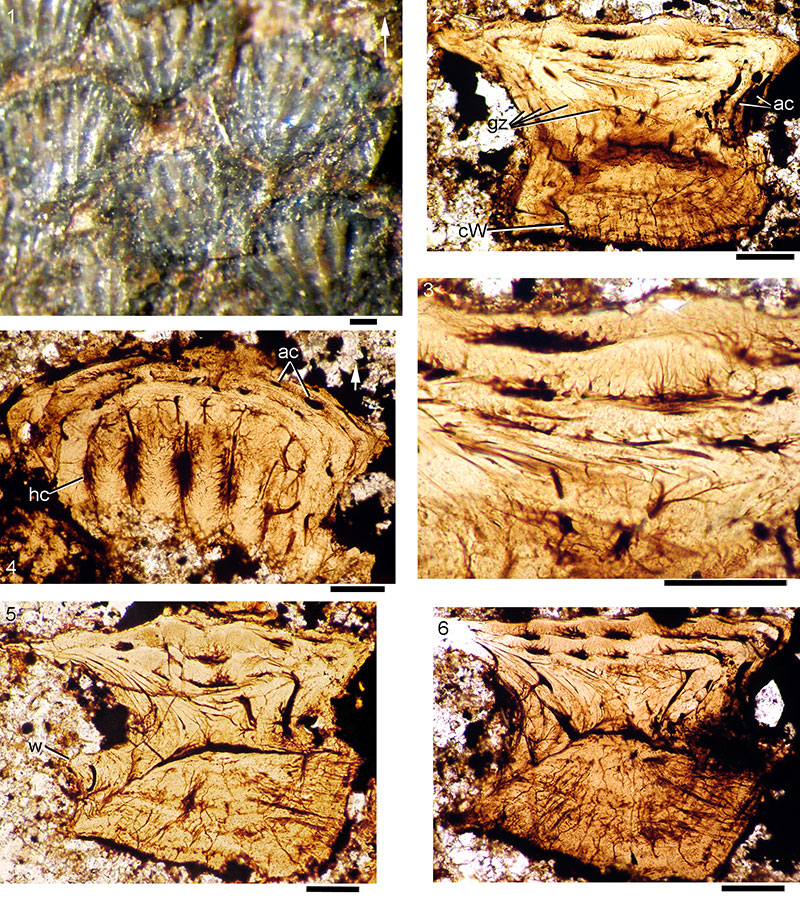
FIGURE 37. Rhadinacanthus longispinus NMS G.2014.44.1 from Cromarty, Ross and Cromarty, scale histology. 1, vertical transverse section; 2, vertical transverse section; 3, vertical longitudinal section; 4, oblique vertical section; 5, vertical section of double scale; 6, vertical longitudinal section. Scale bars equal 0.1 mm. Arrows indicate anterior direction, where relevant.
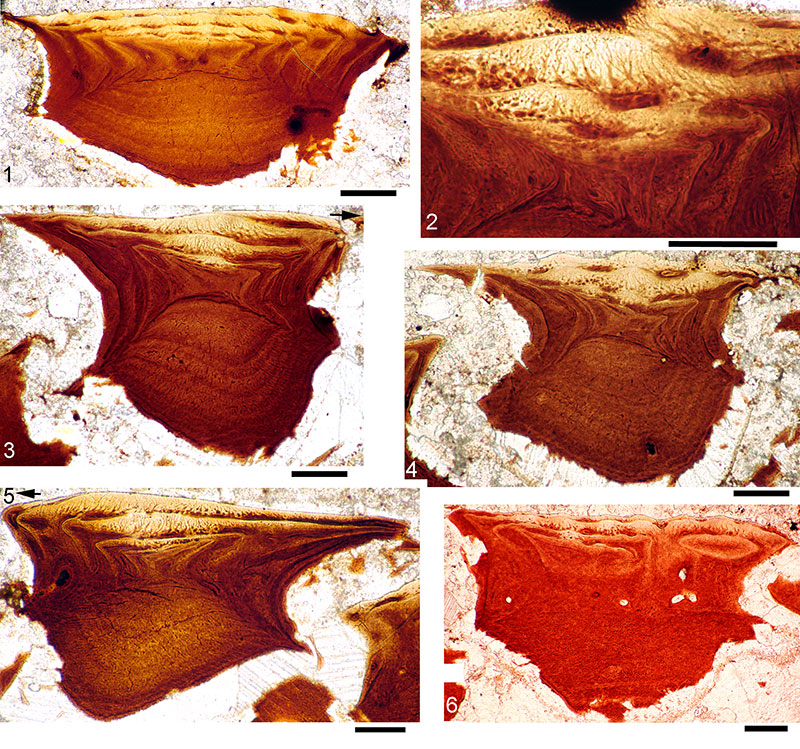
FIGURE 38. 'Life' reconstructions of: 1, Diplacanthus crassisimus, 2, Diplacanthus tenuistriatus, and 3, Rhadinacanthus longispinus.
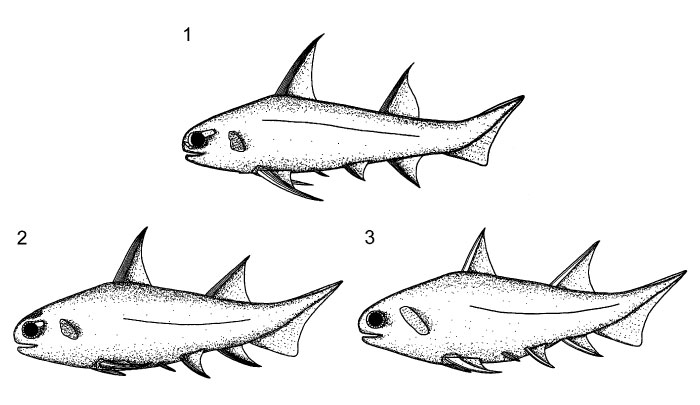
FIGURE 39. Relationship tree generated in phylogenetic analysis of selected early gnathostomes (77 taxa, 262 characters; Tree 1, 641 steps)

FIGURE 40. Strict consensus relationship tree generated in phylogenetic analysis of selected early gnathostomes (77 taxa, 262 characters).
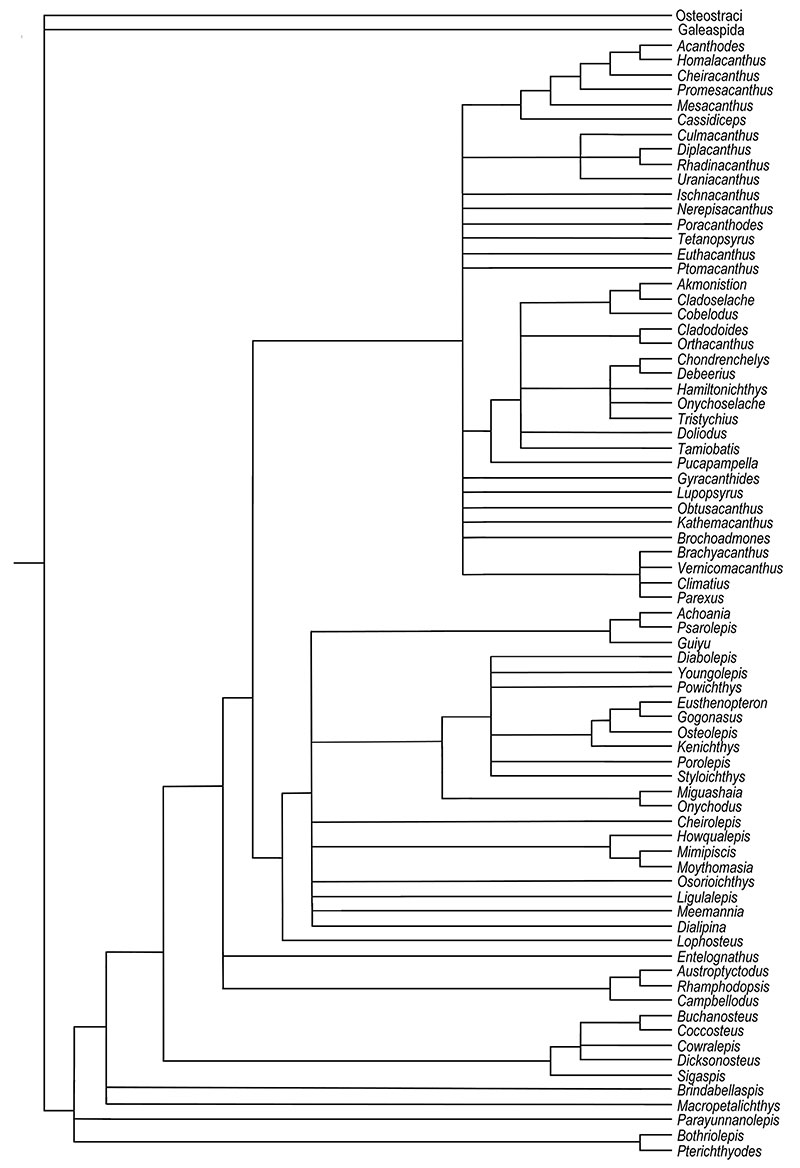
FIGURE 41. 50% majority rule consensus tree generated in phylogenetic analysis of selected early gnathostomes (77 taxa, 262 characters; numbers on branches show bootstrap support %).

The diplacanthid fishes (Acanthodii, Diplacanthiformes, Diplacanthidae) from the Middle Devonian of Scotland
Plain Language Abstract
Our investigations of the form and structure of the fin spines, squamation, and pectoral skeleton of the three diplacanthiform acanthodians Diplacanthus crassisimus, Diplacanthus tenuistriatus, and Rhadinacanthus longispinus from the Middle Devonian of Scotland show that D. crassisimus and D. tenuistriatus are closely related, and the differences between those two species and R. longispinus support assignment of the latter to the separate genus. All three species are also found in the Baltic region, Belarus, and Severnaya Zemlya.
Resumen en Español
Los peces diplacántidos (Acanthodii, Diplacanthiformes, Diplacanthidae) del Devónico Medio de Escocia
Los Diplacanthiformes son un clado de peces acantodios que estuvieron muy extendidos durante el Devónico Medio y principios del Devónico Tardío. Están mejor representados en el Devónico Medio, por fósiles articulados, espinas de las aletas y abundantes escamas, esto último principalmente en el norte de Europa. Tres especies de Diplacanthiformes diplacántidos, Diplacanthus crassisimus, Diplacanthus tenuistriatus, y Rhadinacanthus longispinus, se encuentran en asociaciones del Devónico Medio (Eifeliense-Givetiense), del norte de Escocia, constituidas por peces articulados. Nuestro estudio detallado de las estructuras dérmicas y cintura escapular endoesquelética en estos peces apoya la validez de Rhadinacanthus como un género separado de Diplacanthus, los cuales se diferencian por la morfología de las espinas, la morfología de las escamas, y su histología, y la morfología de la cintura escapular. En Orkney y Caithness, D. crassisimus aparece por primera vez en la biozona de vertebrados Thursius macrolepidotus y deja de terner registro en la biozona de vetebrados Millerosteus minor + Thursius pholidotus. Las especies Diplacanthus tenuistriatus y R. longispinus se encuentran desde la biozona Coccosteus cuspidatus hasta el final de la biozona Millerosteus minor + Thursius holidotus. A través de la comparación de los resultados de nuestro trabajo detallado de la morfología y la histología de las espinas de las aletas y las escamas de los peces articulados con taxones de diplacántidos, a partir en este caso de espinas de las aletas y escamas sueltas de la Región Báltica, Bielorrusia y Tierra del Norte, reconocemos como sinónimos más modernos de las especies de Escocia a muchos de estos últimos taxones de los depósitos contemporáneos. El análisis filogenético de géneros de gnatóstomos seleccionados muestra que los Diplacanthiformes Diplacanthus, Rhadinacanthus, Uraniacanthus y Culmacanthus forman un clado bien establecido dentro de un clado mayor que comprende todos los taxones de acantodios más Chondrichthyes como grupo monofilético.
Palabras clave: Diplacanthus; Rhadinacanthus; Caithness; Orkney; histología; filogenia
Traducción: Enrique Peñalver (Sociedad Española de Paleontología)
Résumé en Français
Les poissons diplacanthidés (Acanthodii, Diplacanthiformes, Diplacanthidae) du Dévonien moyen d'Écosse
Les Diplacanthiformes sont un clade de poissons acanthodiens qui étaient très répandus pendant le Dévonien moyen et le début du Dévonien récent. Ils sont les mieux représentés dans le Dévonien moyen, par des fossiles articulés, des épines de nageoires et d'abondantes écailles, ces dernières étant particulièrement nombreuses dans le nord de l'Europe. Trois espèces de diplacanthiformes diplacanthidés, Diplacanthus crassisimus, Diplacanthus tenuistriatus et Rhadinacanthus longispinus, sont trouvées dans des assemblages de poissons articulés du Dévonien moyen (Eifélien–Givétien) du nord de l'Écosse. Notre étude détaillée des structures dermiques et des ceintures pectorales endosquelettiques soutient la validité de Rhadinacanthus comme étant distinct de Diplacanthus, ces deux genres différant par la morphologie de l'épine, la morphologie des écailles, l'histologie, et la forme de la ceinture pectorale. Dans les Orcades et à Caithness, D. crassisimus est trouvé pour la première fois dans la biozone à vertébrés à Thursius macrolepidotus et disparait antérieurement à la biozone à vertébrés à Millerosteus minor + Thursius pholidotus. Diplacanthus tenuistriatus et R. longispinus sont connus de la biozone à Coccosteus cuspidatus à la fin de la biozone à Millerosteus minor + Thursius holidotus. En comparant les résultats de notre étude détaillée sur la morphologie et l'histologie des épines de nageoires et des écailles de poissons articulés avec des taxons de diplacanthidés connus par des écailles et des épines de nageoires isolées de la région de la Baltique, de Biélorussie et de Severnaya Zemlya, nous reconnaissons nombreux de ces taxons de dépôts contemporains comme des synonymes juniors des espèces écossaises. Une analyse phylogénétique d'une sélection de genres de gnathostomes montre que les diplacanthiformes Diplacanthus, Rhadinacanthus, Uraniacanthus, et Culmacanthus forment un clade bien soutenu au sein d'un clade plus important comprenant tous les taxons acanthodiens plus le clade Chondrichthyes.
Mots-clés : Diplacanthus ; Rhadinacanthus ; Caithness ; Orcades ; histologie ; phylogénie
Translator: Antoine Souron
Deutsche Zusammenfassung
Die diplacanthiden Fische (Acanthodii, Diplacanthiformes, Diplacanthidae) aus dem mittleren Devon von Schottland
Die Diplacanthiformes sind eine Klade von Acanthodiern, die während des Mittleren Devons und frühen Spätdevons weit verbreitet waren. Am stärksten vertreten sind sie im mittleren Devon durch artikulierte Fossilien, Flossenstrahlen und zahlreiche Schuppen, letztere hauptsächlich aus Nordeuropa. Drei Arten von diplacanthiden Diplacanthiformen, Diplacanthus crassisimus, Diplacanthus tenuistriatus und Rhadinacanthus longispinus, wurden in mitteldevonischen (Eifelium–Givetium) Assemblagen von artikulierten Fischen im nördlichen Schottland gefunden. Unsere detaillierte Untersuchung der Dermalstrukturen und des endoskeletalen Schultergürtels dieser Fische unterstützt die Validität von Rhadinacanthus als separate Gattung, die von Diplacanthus getrennt ist. Beide unterscheiden sich in der Wirbelsäulenmorphologie, Schuppenmorphologie und Histologie, und in Gestalt und Form des Schultergürtels. Auf Orkney und Caithness erscheint D. crassisimus zuerst in der Thursius macrolepidotus Vertebraten-Biozone und verschwindet mit der Millerosteus minor + Thursius pholidotus Vertebraten-Biozone. Diplacanthus tenuistriatus und R.longispinus reichen von der Coccosteus cuspidatus Biozone bis zum Ende der Millerosteus minor + Thursius holidotus Biozone. Durch den Vergleich unserer detaillierten Ergebnisse zur Morphologie und Histologie von Flossenstrahlen und Schuppen artikulierter Fische mit isolierten Schuppen und Flossenstrahlen diplacanthider Taxa aus der baltischen Region, Weissrußland und Severnaya Zemlya haben wir viele der letzteren Taxa aus gegenwärtigen Ablagerungen als Juniorsynonyme der schottischen Arten erkannt. Eine phylogenetische Analyse ausgewählter gnathostomer Gattungen zeigt, dass die Diplacanthiformen Diplacanthus, Rhadinacanthus, Uraniacanthus und Culmacanthus eine gut gestützte Klade innerhalb einer größeren Klade bilden, die alle Acantodier plus die monophyletischen Chondrichthyes enthält.
Schlüsselwörter: Diplacanthus; Rhadinacanthus; Caithness; Orkney; Histologie; Phylogenie
Translator: Eva Gebauer
Arabic
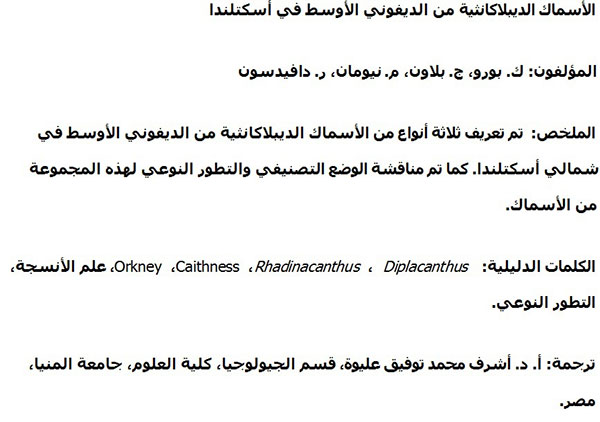
Translator: Ashraf M.T. Elewa
-
-
PE: An influential journal
 Palaeontologia Electronica among the most influential palaeontological journals
Palaeontologia Electronica among the most influential palaeontological journalsArticle number: 27.2.2E
July 2024





 A Review of Handbook of Paleoichthyology Volume 8a: Actinopterygii I, Palaeoniscimorpha, Stem Neopterygii, Chondrostei
A Review of Handbook of Paleoichthyology Volume 8a: Actinopterygii I, Palaeoniscimorpha, Stem Neopterygii, Chondrostei